-
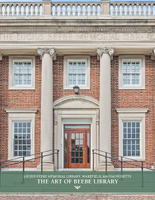 Lucius Beebe Memorial Library Art Brochure 2024
Lucius Beebe Memorial Library Art Brochure 2024 Explore the history behind the artwork on public display.
-
 Library Building - aerial view
Library Building - aerial view Aerial photograph of the library building and front plaza.
-
 Front Door
Front Door Photograph of the main street entrance.
-
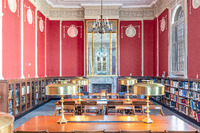 Red Room - left
Red Room - left Photograph of the Red Room's left side, facing the interior of the library building.
-
 Red Room - right
Red Room - right Photograph of the Red Room's right side, facing the front of the library building.
-
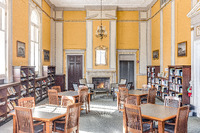 Gold Room - right
Gold Room - right Photograph of the Gold Room / Living Room's right side, facing the fireplace and original external wall of the library building.
-
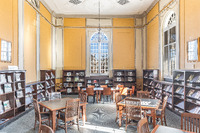 Gold Room - left
Gold Room - left Photograph of the Gold Room / Living Room's left side, facing the front of the library building.
-
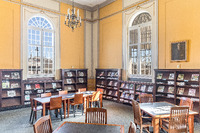 Gold Room - entrance view (left)
Gold Room - entrance view (left) Photograph of the Gold Room / Living Room entrance view, facing left.
-
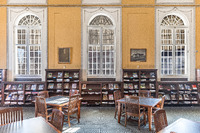 Gold Room - entrance view
Gold Room - entrance view Photograph of the Gold Room / Living Room entrance view.
-
 Paperback Alcove
Paperback Alcove Photograph of the romance/mystery paperback alcove, off the main lobby.
-
 Lobby - facing alcove
Lobby - facing alcove Photograph of the main lobby, facing the romance / mystery paperback alcove.
-
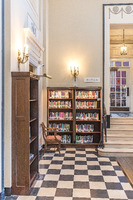 Lobby bookshelf
Lobby bookshelf Photograph of a New Fiction bookshelf in the main lobby.
-
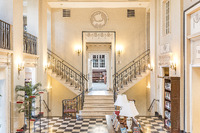 Lobby - facing Gold Room (2)
Lobby - facing Gold Room (2) Photograph of the main lobby, facing the Gold Room/Living Room door.
-
 Lobby - facing Gold Room
Lobby - facing Gold Room Photograph of the main lobby, facing the Gold Room/Living Room door.
-
 Lobby - facing Red Room (2)
Lobby - facing Red Room (2) Photograph of the main lobby, facing the Red Room door.
-
 Lobby - facing Red Room
Lobby - facing Red Room Photograph of the main lobby, facing the Red Room door.
-
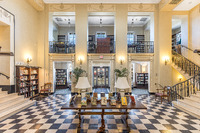 Lobby - facing front door
Lobby - facing front door Photograph of the main lobby, facing the front door.
-
 "Bookplate Suggestions"
"Bookplate Suggestions"
-
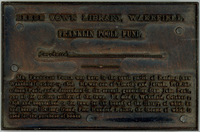 "Franklin Poole Fund" bookplate
"Franklin Poole Fund" bookplate Mirrored scan of the bookplate.
-
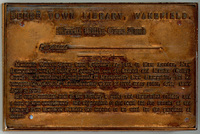 "Merrill Willis Gove Fund" bookplate
"Merrill Willis Gove Fund" bookplate
-
 "John Gould Aborn Fund" bookplate
"John Gould Aborn Fund" bookplate Mirrored scan of the bookplate.
-
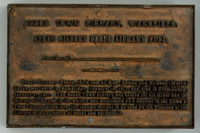 "Cyrus Gilbert Beebe Library Fund" bookplate
"Cyrus Gilbert Beebe Library Fund" bookplate Mirrored scan of the bookplate.
-
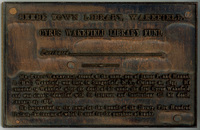 "Cyrus Wakefield Library Fund" bookplate
"Cyrus Wakefield Library Fund" bookplate Mirrored scan of the bookplate.
-
 Geo. E. Lambert Jr., Advertising Illustrations letter 01-10-1923
Geo. E. Lambert Jr., Advertising Illustrations letter 01-10-1923
-
 "Junius Beebe Fund" hand-drawn bookplate template (back)
"Junius Beebe Fund" hand-drawn bookplate template (back)
-
 "Junius Beebe Fund" hand-drawn bookplate template (front)
"Junius Beebe Fund" hand-drawn bookplate template (front)
-
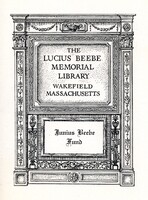 "Junius Beebe Fund" bookplate print
"Junius Beebe Fund" bookplate print
-
 "Books" bookplate
"Books" bookplate
-
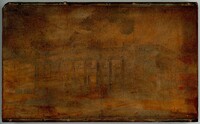 Beebe Library bookplate
Beebe Library bookplate
-
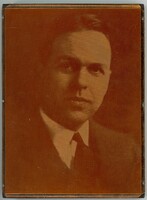 Junius Beebe bookplate
Junius Beebe bookplate
-
 Junius Beebe bookplate
Junius Beebe bookplate
-
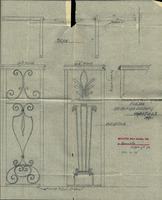 Iron Works Sketch
Iron Works Sketch
-
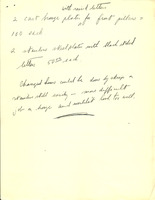 Note Regarding Metal Plates
Note Regarding Metal Plates
-
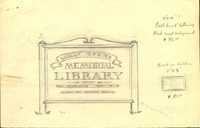 Lawn Sign Sketch
Lawn Sign Sketch
-
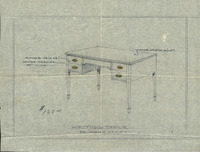 Writing Table Sketch
Writing Table Sketch
-
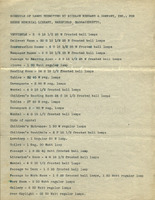 "Schedule of Lamps"
"Schedule of Lamps"
-
 "Orders to Contractor"
"Orders to Contractor"
-
 "The Medallions"
"The Medallions"
-
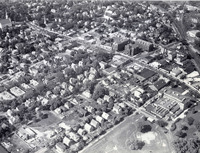 Aerial view of Wakefield, 1948
Aerial view of Wakefield, 1948 This photo was taken by Cheyne Aerial Surveys of Methuen in 1948. According to the photo caption that appeared in the Boston Herald, "Take a good, long look at this suburban community, its main thoroughfare running from top left to right center of the picture, its athletic field at the bottom right, and two churches in the upper left corner. It's Wakefield from the air."
-
 Stereograph of Lake Quannapowitt :circa 1880s
Stereograph of Lake Quannapowitt :circa 1880s This photograph is identified as having been taken by C.F. Richardson at Prospect and Elm Streets. In "Wakefield As It Is", a promotional booklet published by Chester W. Eaton's Real Estate Agency in 1880, the Boston Globe noted on May 2, 1880, "Eaton's real estate exchange reports an active demand for houses in the beautiful town of Wakefield., which is full of charming locations and various attractions. This agency, which is located at Wakefield, has houses and estates of every description ranging in price from $1,000 to $12,000 and building lots at reasonable figures. No suburban town is more popular for residential purposes than Wakefield, and its growth is sure and steady."
-
 G.W. Eaton, Grocers :Main Street, 1896
G.W. Eaton, Grocers :Main Street, 1896 G.W. Eaton, Grocers was located at 394 Main Street from 1889 to 1917. Owned by George W. Eaton, a lifelong resident of Wakefield, the store sold a variety of items some of which were featured on advertisements on display at the store, including Quaker Oats; Bon Ami, a cleaner developed in 1886 by the J.T. Robertson Soap Company; products baked by the New York Pie Bakery, located in Massachusetts; chocolate and cocoa from the well-known chocolatier Walter Baker & Company of Dorchester; and smoking materials from J. G. Dill's Tobacco Company of Richmond, Virginia, a company which received four patents for chewing and smoking tobacco in 1878. The picture may have been taken in February 1896, as indicated by the 29 days on the calendar on the wall . It is interesting to note that the next leap year did not occur in 1900, rather it occurred in 1904. A leap year is every four years, but not every 100 years. Since 1752 in the United States, years exactly divisible by 100 are only leap years when they are also exactly divisible by 400. For example, 1800 and 1900 were not leap years, but 1700 and 2000 were. When Eaton retired in 1917 after 28 years in the grocery business, he disposed of his goods and closed the store, not selling the business to anyone else.
-
 Wakefield High School Battalion Officers :1920-21
Wakefield High School Battalion Officers :1920-21 (Seated left to right) Captain Arthur Moncrieff, Captain Francis Bowman, Major Richard Dolbeare, Captain Roy Surrette and Captain Charles Carr. (Standing, left to right) 1st Lieut. Philip Pasqualino, 2nd Lieut. Winsor Finney, 1st Lieut. Frank DeFazio, 2nd Lieut. Myron Wing, Adj. A. Anderson, Battalion instructor Sergeant Ernest Monroe, 1st Lieut. Francis Walsh, 2nd Lieut. Abbott Fiendel, 1st Lieut. Cecil Ward, 2nd Lieutenant Robert Batten, and 1st Lieut. Samuel Levine.
The Wakefield High School Battalion was created in October 1885, when the "boys of Wakefield High School" formed a military company and entered into the Second Massachusetts Regiment with cadets from Reading and Andover. During the 1920-21 school year, the Battalion was said to have "advanced farther" than in other years under the instruction of Sergeant Monroe of the United States Army. The battalion's four companies met for drill three periods each week, with an officers' school held every Tuesday afternoon to instruct the officers and non-commissioned officers. For several years, the companies which made up the Wakefield Battalion held spring prize drills in the Town Hall and later on the park (common). Due to crowded conditions at the High School and overcrowding of the program, military drills were abolished in 1931. The program was resumed with the entrance of the United States in World War II and was required of all boys in the junior and senior classes, as military training was valuable to the young men entering the service.
-
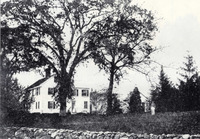 Frederick Ballard Eaton House :Main Street near Sweetser Street, circa early 1900s
Frederick Ballard Eaton House :Main Street near Sweetser Street, circa early 1900s Referred to as the Frederick Ballard Eaton House on Main Street near Sweetser Street, this home was reported to be occupied by Frederick's widow Eliza in Lilley Eaton's Genealogical History of Reading Mass., published in 1874. Frederick was born in Reading (now Wakefield) in May 1792, one of five children born to Samuel Eaton III and Sarah (Evans) Eaton. He married Eliza Vinton in 1815 and the two were parents of five children: Sarah, Henry, Mary, Hiram and Joseph. Sarah married George Reed Morrison, a Deacon in the First Parish Congregational Church and one of the first corporators of the Wakefield Savings Bank. Frederick died in 1858. It is not known when the house was built. The Frederick Ballard Eaton House is believed to be the house occupied by William Stimpson in 1812. According to Lilley Eaton's book, Stimson "was a bricklayer by trade, a peaceable, industrious, and honest man. He afterwards purchased and occupied the farm at the 'head of the pond', now or lately known as the 'Stimpson Farm'," probably the historic house now at 22 Prospect Street. Frederick Ballard Eaton built another house, the Greek Revival style home to the south of the original house, now 196 Main Street, for his son Hiram. A map of 1856 shows two Eaton houses at the corner of Main and Sweetser Streets.
-
 Kingman Block, 369 Main Street :September 1923
Kingman Block, 369 Main Street :September 1923 One of the oldest commercial buildings in downtown Wakefield, the Kingman Block, was built around 1860 during the tenure of Samuel Kingman, a tailor who later became Postmaster. Now known as the Bourdon Building, the building housed the Post Office until 1901 when it moved to the corner of Main Street and Richardson Avenue. During the late 1800s, Kingman's Hall was on one of the upper floors and was used for social parties and assemblies. The third floor was once the armory of the Richardson Light Guard, as well as the A.O.H. Hall and the Red Men's Hall. After the Post Office vacated the building, the bottom floor of the building was altered over the years to accommodate many businesses, including Wilhelmina's Smart Shop, O'Connor's Men's Shop, and Wm. M. Deadman's Market which was on the Albion Street side of the building. Kenwood's Lunch was the occupant of the first floor when this picture was taken on September 21, 1923 just before the razing of the Bessey Livery Stables pictured on the right. Kenwood Lunch advertised that it was an American restaurant with American food and management and encouraged readers to "come and enjoy a real good meal. We solicit your patronage and guarantee satisfaction." The Willard Service Station, the taxi office of Richard Barrett, and the Victor Shoe Shine Parlor, to the right of the Kingman Building were also razed in November 1923 in preparation for the Wakefield Trust Company building.
-
 Company A leaving for Camp Devens :World War I, August 1917
Company A leaving for Camp Devens :World War I, August 1917 Company A, Sixth Regiment of the Richardson Light Guard, was mustered into service on April 6, 1917. Less than 12 hours later, Company A was on its way to Fort Revere in Hull. On August 25th, the company was allowed to return home for a day before being sent to war. A farewell parade was held on Sunday which started at the Armory (now the Americal Civic Center) and ended at the Upper Train Station. According to Wakefield Massachusetts in the World War 1917- 1920, a book started by Emma Florence Eaton (who worked on the project from 1919-1921), and completed in 1935 under a W.P.A. project, more than 900 Wakefield men and women were enrolled in the various branches of the service. A total of 41 gave their lives to the cause, 97 were "gassed" or wounded, 27 received "decorations for valor," and 37 were cited for gallantry in action when the war ended in 1919. Pictured after the company passed through the town during the 1917 farewell parade, thousands of local residents returned to their homes or walked or rode to the train station for the final good-bye. It is interesting to note that the sign in the foreground reminds drivers to "keep to the right. Please observe the law." It is also important to not only note the dress on what was probably a hot August day, but to also note the cars, one of which has the steering wheel on the right.
-
 Fourth of July celebration, 1957
Fourth of July celebration, 1957 The annual Fourth of July celebration, sponsored by the West Side Social Club, featured children's activities and contests, a three-division parade which began at Moulton Playground and ended at the Common, a band concert, and fireworks. The parade, the largest in the events history, stepped off at 2 p.m. on a route that traveled along Albion, Gould, Walnut and Chestnut Streets, North Avenue, Main and Church Streets. Several of the children's activities, including the fishing derby, home run hitting contest, pet "show", and a boys-only bicycle, tricycle and cart parade were held the night before, beginning at 6:30 p.m., followed by a band concert, variety show featuring three vaudeville acts and a "sample" fireworks display. The remaining children's events, including the children's races and doll carriage parade were held on the morning of July 4th, some of which were featured on WBZ-TV's live broadcast from 11 a.m. to 1 p.m. and on Bob Emery's Big Brother show. The parade floats which "appeared in the line of march" in the afternoon "assembled for a trip before the cameras on Church Street in front of the bandstand and several marching groups also were shown at 11 o'clock." Brian Goss, on the bicycle was the second-place winner in the bicycle parade, which won him a "crest lite." He and his mother, Ruth, are pictured with what may be the other winners who were reported to have been interviewed by Bob Emery on his show.
-
 Building of Clipper Cove, Pleasure Island :June 5, 1959
Building of Clipper Cove, Pleasure Island :June 5, 1959 According to the photo caption on the back of the photo, "PIRATE HIDEOUT - Shipfitters set the rigging on a pair of pirate boats moored to the wharf on the shore of Pleasure Island's currently calm inland sea." The photo was taken just weeks before the June 22nd public opening of the park. The designers and construction crews were able to turn swampland into the Disney of the East in less than one year, starting earth-moving operations in the Fall of 1958, working through a New England winter and above average rainfall amounts during the 1959 spring and summer. This photo shows portions of the park's main themed areas, Clipper Cove, on the left, and the Western section called Goldpan Gulch, above right. Clipper Cove was designed to represent a New England seaport from the mid-1800s. It incorporated the Pirate Cove and Moby Dick attractions as well as the Wreck of the Hesperus dark ride. The Western section featured the narrow-gauge steam train "Old Smokey" and the Goldpan Gulch Station, the Diamond Lil Saloon, Quannapowitt Publishers Print Shop, the Chisholm Trail dark ride, and an 1800s and Contemporary Hotel exhibit by Hotel Corporation of America. At the top of Clipper Cove (left to right) is the Hotel Exhibit, the dark ride, Print Shop, and Saloon. Facing Clipper Cove at the rear of the Hotel Exhibit was the Sheriff's Office and Jail. Across from this complex was the popular Tilt House, often referred to as the Slanty Shanty. On the left beyond the launch platform for the Pirate Cove attraction was Cap'n Snow's Chowder House, which was still under construction. Several other attractions also opened in the park's first season, some survived for the entire 11 seasons while others were either added or removed, including the park's shops and dining facilities. This year also marks the 50th anniversary of Pleasure Island's 11th and final season. Wakefield hosted the second of three theme parks built across America after Disneyland and although long gone, Edgewater Office Park maintains much of the past landscape and water features enjoyed by the millions of former guests, young and old.
-
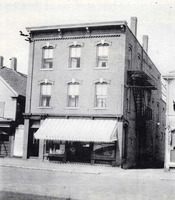 Wakefield Clothing Company :390 Main Street, circa 1923
Wakefield Clothing Company :390 Main Street, circa 1923 This building, occupied by the Wakefield Clothing Company in 1923, once numbered as 390 Main Street, was located across from Avon Street. While most prominent buildings in downtown Wakefield were often referred to by either the name of their builders or occupants, this building is not as identifiable. It could have been called the Daland Building in the late 1800s, as it was owned and occupied at the time by the Everett G. Daland Dry Goods Store. The store measured 75' x 20' and provided a "large and fine assortment of dry goods, children's clothing, men's furnishings, hats and various small wares too numerous to mention." It is reported that Everett George Daland, a Wakefield native, opened the dry goods store in 1878 at the age of 18. He opened the store for 23 years and went on to work as a traveling salesman for Simon, Hatch and Whitten Company of Boston, a wholesale men's furnishings company for the next 30 years. The building itself is similar to, and often mistaken for, the Butler block which is located on Main Street across from Albion Street.
-
 Emerson Homestead :Lawrence and Main Streets, circa 1906
Emerson Homestead :Lawrence and Main Streets, circa 1906 Although there were several houses owned and occupied by members of the Emerson family, this is probably the home of Thomas Emerson, founder of Thomas Emerson & Sons at the corner of Main and Lawrence Streets. According to the Historic Homes and Places and Genealogical and Personal Memoirs Relating to the Families of Middlesex County, Massachusetts published in 1906, Emerson was born in 1785 and died in 1871. He and his wife Elizabeth Hartshorn, said to be the sister of Col. James Hartshorn, were the parents of five children: Thomas, Augusta, Sarah, Maria and James. James, the youngest, is the only child listed as being born in the home in 1830. Thomas Emerson was credited with instituting a system of paying wages in cash instead of "barter at the store," once a practice of shoe manufacturers. A Selectman, member of the School Committee, Representative to the General Court and a State Senator, the elder Thomas was one of the "most prominent citizens and business men active in political affairs" with a "charming personality and sterling character," traits carried on by his two sons, Thomas and James, both of whom are credited with growing the business in "volume and prosperity" and continuing his community and civic service. After their father's retirement in 1854, his two sons renamed the company Thomas Emerson's Sons. The younger Thomas was one of the founders of the Wakefield Horticultural and Agricultural Society, and although he was an integral part of Thomas Emerson's Sons, he also served as President of the Mechanic and Agricultural Institution, a bank, for 24 years, and as a trustee of the Wakefield Savings Bank and director of the National Bank, along with many other organizations. James Emerson followed his father's civic sense of duty as Town Treasurer for 28 years. He is credited as being a "leading spirit in the organization" of the Richard [i.e. Richardson] Light Guard, serving as Commander of the company, was the second President of the Wakefield Savings Bank, and was an organizer and charter member of the Wakefield Home for Aged Women (the Boit Home.) He played a "prominent role" in bringing water, electricity and gas to the town, and in acquiring land bordering Lake Quannapowitt for use as a public park. He died in the family home in 1906.
-
 L.B. Evans, Water Street, circa 1942
L.B. Evans, Water Street, circa 1942 The building at 29 Water Street, former home to L.B. Evans Son Co. Shoe Manufacturers, was built as a three-story, 60' by 40' building in 1894. Founded in 1841 by Lucius Bolles Evans in a building at the at the rear of a dwelling house at 9 Salem Street, the shoe manufacturing shop moved to 8 Salem Street in 1884. In 1894, Lucius' son, Harvey B. Evans built the new shoemaking factory on the site formerly occupied by the Episcopal Church, employing 80 people.The company was incorporated as the L.B. Evans' Son Company in 1905 by Harvey Evans' sons following his death. A 40' addition and a fourth story were added somewhere around 1904, with many other additions made over the years, bringing the total square footage to 117,000 sq. ft when the final addition was completed in the late 1960s. Once recognized as the oldest shoe manufacturing concern in the United States and the oldest industry in Wakefield, the company and its building were purchased by a Fitchburg Company in 1979 and the company began to be phased out in 1980, eventually closing around 1987. The company was best known for its slippers and casual shoes in its later years. Although it appeared that the Burche Manufacturing Company was located in the L.B. Evans building, the angle of this photograph made it appear that the company's sign was on the building, according to a press statement on the back of the photograph.
-
 Ice harvesting :circa late 1880s
Ice harvesting :circa late 1880s Frederick Tudor, a prominent Boston merchant referred to as the "Ice King of New England" in the early 19th century began harvesting ice from ponds and lakes across Massachusetts beginning in 1805. He harvested ice from both Lake Quannapowitt and Crystal Lake, as well as several other area lakes and ponds, that were shipped to areas as far south as Charleston and New Orleans, and as far as the West Indies. Ice harvesting in Wakefield increased with the creation of the Quannapowitt Railroad Company in 1849 to transport ice from storage to the main railroad and to points beyond. By 1855, 27,000 tons of ice were harvested from both Lake Quannapowitt and Crystal Lake for an estimated value of $13,500, employing 20 men, making the town the fourth largest source of commercial ice in Middlesex County. In its heyday, there were more than three dozen ice houses operating at one time: the 24-ice house Boston Ice Company, the People's Ice Company, the Whipple-Morrill Company, Morrill-Atwood Company, and the Nichols Ice Company, all on Lake Quannapowitt; and three on Crystal Lake: the Philpott houses near the "Greenwood Bridge", a "set of houses" on [sic] at the corner of Crystal Lake Park near the Town nursery, and another on the east shore near the Junction railroad station. The picture shows the workers getting the cut ice into the ice house. According to Alonzo Colson's accounts published in the Wakefield Daily Item in 1947 and 1948, the connecting links between the ice houses and the "ice fields" were called runs, which were two 100-foot platforms of heavy boards, each five feet apart, five feet wide and two feet above the water. The ice cakes would float between them and long chains would go down into the water to pick up the cakes that workers had "poled" along and put on the chains, which were two "flat-faced" link chains five feet apart and seven to eight inches long. A hardwood cross bar connected the two chains which picked up the ice cake from the "submerged big wheels upon which it rolled." The ice was then slid onto iron tracks to the desired storage level.
-
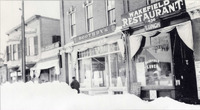 Boothby's Specialty Shop :432-434 Main Street, circa 1920s
Boothby's Specialty Shop :432-434 Main Street, circa 1920s Boothby's Specialty Shop began as Boothby's Beehive when Asa and Mabel Boothby purchased The Emerson, a dry goods store owned by Bernice Emerson across the street in the Traders' Block, in 1907. Daily operations were handled by Mabel while Asa worked as a salesman, and later as sales manager, for Wadsworth-Howland Co. The store moved across the street into the Butler Block, then numbered 432-434 Main Street, in 1919 in a store previously occupied by Butler's variety store and, with the addition of more merchandise, became a women's specialty store. The couple purchased the building from the estate of Aaron Butler in 1923 and remodeled it in 1936 by adding a 75' one-story addition in the rear, removing the yarn shop on the second floor and adding four kitchenette apartments. Both Asa and Mabel Boothby were active in the community; he as a Selectman, Chairman of the Salvage Committee during World War II, and as an officer of several professional, civic and religious organizations; and she as Noble Grand of Goodwill Rebekah Lodge, No.22, I.O.O.F, and as an officer of other civic and religious organizations. The business was sold to W.T. Grant Company Manager Leslie Gaquin in 1944, who also purchased in the building in 1946.
-
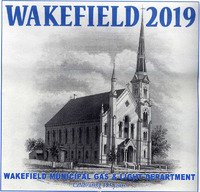 First Baptist Church, 1872
First Baptist Church, 1872 The stately First Baptist Church was destroyed by a seven-alarm fire on October 23, 2018. The church is described in the 250th anniversary publication of 1894, after addressing a fire that destroyed its second house of worship in 1871, as follows: "The people had already felt the need of more ample accommodations, and, with strong hope and courage, secured a lot of land on the corner of Main and Lafayette Streets, where the foundations of worship were laid. This structure, which is no exception to the unwritten law that calls for attractive public buildings in the town, was dedicated (on) Dec. 11, 1872. Built of wood, it belongs to the Romanesque order, with minaret and lofty spire, one hundred and eighty feet from the base. the spacious auditorium was designed for one thousand people".
-
 Wakefield Square :circa 1980s
Wakefield Square :circa 1980s Image from the Wakefield Municipal Gas and Light Department annual calendar, 2021
-
 Greenwood gathering :circa 1930
Greenwood gathering :circa 1930 The other half of the Greenwood gathering appearing elsewhere in this calendar features a glimpse at some of the local businesses that exhibited their wares at the circa 1930 gathering in Greenwood. H.S. Sorensen, a local jeweler, is in the center, and on the right is the display of the J. Wallace Grace Hardware Company, a hardware and plumbing store that was located at 14 Albion Street and started in business in the mid-1800s. The store may have been associated with the International Oil Burner display, at right, which touted the new type oil burner that, according to industry publications, "took the place of wood or coal and automatically and silently changes cheap oil into one of the quickest and hottest fires known." It was said to burn 96% air and 4% "cheap oil" and fit in the fire box of any range, stove or furnace. George Archibald is also in this part of the picture, wearing a sweater, knickers and striped socks, standing alone with his left hand touching his face.
-
 Crescent and Eaton Streets :1930
Crescent and Eaton Streets :1930 This photograph was taken from the steeple of the Baptist Church, looking southeast. The view shows several prominent buildings and structures, most notably the Unitarian-Universalist Church of Wakefield, at the right, the factory building once referred to as the "Old Rink Building" and former home to the Richardson Light Guard armory, the Lincoln School, and the Heywood-Wakefield Company, formerly the Wakefield Rattan Company, and later the Robie Industrial Park. The photograph was taken before the 1951 police station was built, now part of the Public Safety Building. The 1900 fire station is not pictured but is to the right of the top of the church steeple. Note the homes with barns and the absence of automobiles in the driveways and on the roadways.
-
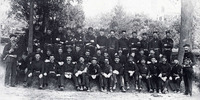 Veteran Firemen's Association :Crescent Street, opposite Mechanic Street, circa 1890s
Veteran Firemen's Association :Crescent Street, opposite Mechanic Street, circa 1890s Wakefield's Veteran Firemen's Association appears to have been among the most active of the veteran firemen's organizations in the Commonwealth in the late 1890s. Comprised of "old-time firemen," the members of the association took part in numerous balls, parades, and competitions organized by the New England States Veterans Firemen's League in the 1880s and 1890s. The Veteran Firemen's Association was organized in January 1889 with 45 charter members. Early officers included President W.A. Cutter, Vice President E.H. Walton, Secretary George Weston, Treasurer E.E. Whiton, and Foreman Alexander Flanders. The April 1889 Town Meeting approved the use and custody of the Yale Engine No. 1 to the group, later selling it to them for $1 in November 1891, with the condition that the hand tub be kept in good condition for use at all fires, and "subject to duty whenever required by the Fire Engineers of Wakefield." The engine could not be sold without the consent of the Town and would revert back to the Town when the company disbanded. During one outing in Boston in September 1892, the Wakefield group was among more than 3,000 uniformed members representing 25 companies and 23 engines, some of which were hailed as the "best in the nation." The competitions included engine tests with Wakefield's Yale Engine coming in third with a horizontal stream of 205', 2.75". The Yale, named after noted citizen and benefactor Burrage Yale, was destroyed in a fire at the Central Fire Station in 1899. the association participated in the Town's 250th anniversary celebration in 1894, which may be the occasion for the photograph. Note the Yale name on the belt buckles.
-
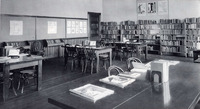 Greenwood Branch Library :1934
Greenwood Branch Library :1934 The Greenwood Branch of the Beebe Town Library opened in October 1904 at the "new" Greenwood School building. According to the 1904 Town Report, the library started as a twice-weekly delivery "by an attendant" to Greenwood residents. By February 1905, 876 books had been circulated and 60 "application" cards had been requested. The Greenwood Branch Library was open on Mondays and Thursdays from 3:30 p.m. to 5 p.m., and in January 1906 its hours were expanded to include Saturday evenings from 7 p.m. to 8 p.m. The library branch was so popular that the Saturday hours were increased to 6:30 p.m. to 8:30 p.m. and a room in the school was eventually dedicated to library operations on Mondays, Thursdays and Saturday, a schedule that remained in place for decades. During the early 1930s, improvements were made to the Greenwood Branch Library under the direction of Librarian Clara Wilson. The 1933 Town Report describes the library rooms as "inviting and homelike and are taking on a real place in community life. Decorations suitable to the various seasons are arranged and there is always some scene in the glass case of interest to both children and grown-ups." In 1962, the library rooms were needed for classrooms, and the branch library was moved to smaller space within the school. The branch closed in September with its books stored in the basement until its new home was finished in "conjunction" with the Greenwood Fire Station. The Greenwood Branch Library officially opened in its new home in the station on May 5, 1963.
-
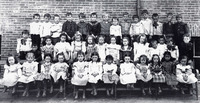 Grades 1 & 2, Hurd School :circa 1902
Grades 1 & 2, Hurd School :circa 1902 The building of a new brick schoolhouse in Wakefield North Ward was approved at Town Meeting in early 1898 to address crowded conditions in the existing schoolhouse which had required "96 scholars" to attend the Lincoln School. The North Ward was considered to be the area between Main and Salem Streets, west of the Newburyport Branch of the B&M Railroad, and the building was the third new school to open in as many years. After debate, the meeting voted to build a four-room two-story school building at a cost of $12,000 on a 13,000 foot lot at the intersection of Cordis Street and a private way which ran north of Cordis Street, rather than move and repair the existing school building. It was also voted at a subsequent meeting to name the school in memory of Dr. Francis P. Hurd, 'cultivated, refined, and philanthropic citizen' who had bequeathed $2,500 to the Beebe Library. The first and second floors were identical, with a vestibule, corridor, coat rooms and a lavatory, teachers' room, and two classrooms, each measuring 28 ft x 32 feet. In the 1901-1902 school year, the faculty included Principal Eleanor F. Emerson, a graduate of Salem Normal School; Jennie Carter, Millbury High School, grades 1 and 2; Isabel G. Flint, Salem Normal School, grades 3 and 4; and Eva Howlett, Salem Normal School, grades 5 and 6. According to the 1901 and 1902 Town Reports, 44 students were enrolled in grades 1 and 2 in all of 1901, and 50 students enrolled during the first five months of 1902.
-
 Junior Olympics, Pleasure Island :1962
Junior Olympics, Pleasure Island :1962 Before the start of the 1962 season, Pleasure Island's managing director, Walter Smith, cleared the land between Baby Animal Land and Indian Village and transformed it into an athletic event complex. According to a press release issued on July 19th, 1962, "Inspired by the President's Physical Fitness Campaign for Youth, Pleasure Island has implemented a Junior Olympics program which is the first kind in the country." The program was run by Peter Rommell of Boston University's athletic staff, and children could "not only watch shows and enjoy rides at the park, but also take part in a painless physical education program." There was no charge for participation in the fitness competition, which was held in the Olympic Stadium "set off by flags of 64 nations." According to a park press release, a member of the "carefully-selected" staff which oversaw the program was Northeastern University student Richard Kelley of Wakefield, who went on to be a long time physical education teacher in Wakefield. Pleasure Island hosted the Junior Olympics during the 1962 and 1963 seasons, with 7,850 children participating in the first season. Boys and girls from 6 to 18 scored points in several different events, including "chin-ups, push-ups, sit-ups, squat thrusts, high jumps, standing broad jumps, deep knee bends, and a 50-yard dash." The high scorers from each day were invited back at the end of the season for the semi-finals and finals. The winners of the final competitions held on September 2nd, 1962, Paul Sweeney, 13, and Leslie Stevenson, 10, traveled to Washington, D.C. with Pleasure Island's Director to meet President John F. Kennedy in January 1963. At the end of the 1963 season, winners Beth McBride, 14, and Charles Pantos, 16, each received a gold medal and a $50 US Savings Bond. The Olympic fields were located on what is now parking lots between buildings 101 and 201 in Edgewater Office Park.
-
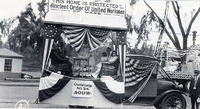 Crystal Lodge, A.O.U.W. :July 4, 1922
Crystal Lodge, A.O.U.W. :July 4, 1922 Wakefield's Crystal Lodge of the Ancient Order of United Workmen (A.O.U.W.) participated in the float division of the July 4th parade in 1922. According to regional news reports, the organization's float entry was "depictive of the order" which is credited with being the first fraternal group that introduced fraternal Insurance to its members, a benefit that was only available to "businessmen and manufacturers." Founded in Pennsylvania in 1868 by John Jordan Upchurch, the A.O.U.W. was established as an organization that would be responsive to the needs of its members while uniting labor and management. Originally intended to serve men in the mechanical trades, the A.O.U.W. opened its membership to other occupations just two years later. The parade was part of a $5,000 celebration organized under the auspices of the Chamber of Commerce. More than 50,000 people were reported to have attended the event which began with a Gallo's Band concert and bonfire at midnight the night before at the Greenwood ballfield, and continued through the day with the "street" parade at 10 a.m., a baseball game, sporting events, and another concert by Gallo's Band. The $1,000 fireworks display, and the flying exhibition on parachute drop were postponed due to weather, with the fireworks slated for the next "first pleasant evening." In addition to the floats, the parade, led by Col. Edward J, Gihon, included a military division, 20 fraternal organizations, an industrial division, veterans of three wars, decorated cars and "horribles."
-
 Silsby Steamer at Crystal Lake :circa 1941
Silsby Steamer at Crystal Lake :circa 1941 The Lucius Beebe Steamer No. 1, often referred to as the Silsby Steamer, was Wakefield's first steam and horse-drawn engine. Built by the Silsby Manufacturing Company of New York and purchased by the Town at a cost of $3400 in 1882, the steamer was a replacement for the Yale hand pump engine. The Town had its first look at the Lucius Beebe steamer and its 400 gallon-per-minute capabilities at an exhibition at Carter's Pond on the corner of Main and Crescent Streets that year. The steamer and its hose and supply wagons were first stationed at the fire station on the lower Common, and later moved to a newly built firehouse on Crescent Street in 1894. The horses were housed at the nearby Hathaway Stables. To keep the horses active, they were loaned to various Town departments, including the Highway Department which use the steamer to water its gravel roads during the summer. The Silsby Steamer was replaced by the Amoskeag Steamer in 1908 and placed in reserve service. The steamer was taken out of reserves and given to the Water Department for use at the Broadway pumping station in 1928 "for standby in the event of failure of electric power." In the early 1940s, the steamer remained at the Broadway station "ready to be used to quench fires and for auxiliary water supply." Wakefield was in a severe two-year drought in 1940 and 1941 which caused Crystal Lake to be 81" below the high watermark in 1941. The Silsby steamer was rebuilt and used to pump water from Crystal Lake into the filter. The drought created an expansive shoreline as the picture shows. Note the Junction train station which can be seen in the background.
-
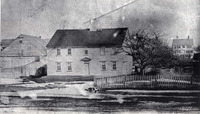 Old Smith house :Main and Water Streets, circa 1867
Old Smith house :Main and Water Streets, circa 1867 Historical references indicate that the Old Smith House was built by the Reverend Samuel Haugh prior to 1662 and stood at Main and Water Streets. Haugh is believed to have "come over" to this country from England with his father after Atherton Haugh in 1634. As the second minister of Reading, now Wakefield, he began preaching in Reading in 1648 and was ordained in 1650. He died in 1662 and left all the houses, land and "quick stock" that he was in possession of within the Town of Reading to his daughters Elizabeth, Sarah and Mary. In addition to the Reading possessions he also owned land and houses in Boston, Cambridge, and Braintree. Elizabeth lived in the house with her husband Capt. John Herbert, a mariner and sea captain who went on to serve as Town Clerk and as a Selectman several times. The house was later occupied by her daughter Mary and husband, Deacon Thomas Nichols. The house was sold by Thomas Nichols to Capt. David Smith. Smith's son Noah lived in the house until his death in 1859. Noah was also a Selectman as well as a justice of the peace, representative and an officer of the calvary [i.e. cavalry]. The house was moved to 15 Lincoln Street in 1868 to make room for the Cyrus Wakefield Town Hall and remained standing until the 1950s. Smith Street was originally the alley that ran behind the Smith house, according to the August 21, 1921 edition of the Wakefield Daily Item, and it later became the street between the Town Hall and the Miller Piano factory. The article also claimed that Smith Street was probably the shortest street in Massachusetts, at just 100 yards in length, and without a single house.
-
 Greenwood gathering :circa 1930
Greenwood gathering :circa 1930 This undated landscape picture, believed to have been taken around 1930, belongs to Ola Florence Dow Archibald Hatch of Greenwood, the social correspondent for the Wakefield Daily Item and a member of a large family with many local ties. Ola was one of five children of George and Clara Dow, born in 1892; Charlotte (Da)y, born in 1895; Clarence "Click", born 1897; Everett, born in 1900; and Ida (Glidden), born in 1901. Clara was also the social correspondent for the Wakefield Daily Item, a position Ola took over when her mother retired. The photo is two pictures put together; the other is featured on the back inside cover of this calendar. Ola's husband Samuel Archibald worked in the Town Clerk's office and is the tall man standing at the left with his hands in his pockets, while their son George is the sixth boy to the right of the man in the striped suit. Sadly, George died in 1931 of meningitis, and Samuel in 1933 of tuberculosis. Ola married Milan Hatch, a widower who had three sons and a daughter, in 1934. Their daughter, Judy, was born in 1935. Milan also served the Town as a blackout warden during World War II. In addition to the Dow, Hatch, Day and Glidden families, other Wakefield family members included the Forlizzi and Pelletier families. The photo was taken in Greenwood at what may have been the Greenwood ballfield/park off Pitman Avenue, behind the Pitman estate, or the Grove which was located near Forest Street. The Greenwood ballfield was the site of many community events in the 1920s and 1930s, including a midnight bonfire on July 3rd, 1922, which kicked off a massive $50,000 July 4th celebration.
-
 Dr. Cushman's house, Vernon Street :circa 1865
Dr. Cushman's house, Vernon Street :circa 1865 According to US Census reports, Rev. Robert Woodward Cushman, D.D., a highly respected preacher and teacher throughout the Northeast, lived at the Vernon Street home in 1865 that had once been occupied by Thomas Emerson in 1765, and shoemaker John Sweetser in 1795 and 1812. The Baptist "clergyman" lived in the home with his wife Eliza and their daughter Ella, a teacher. Records indicate that the real estate was valued at $4,000 while his personal wealth was $1,000 indicating that he was a man of wealth. Born in Maine in 1800, Dr. Cushman was orphaned early in life, and at 14, According to US Census reports, Rev. Robert Woodward Cushman, D.D., a highly respected he began working as a cabinetmaker apprentice, watchmaker and jeweler. At the age of 16, "the influence of religious truth awakened him to a new life" and he went "from house to house, exhorting the people to repent." He went on to study under several notable preachers and graduated from Columbian College, now George Washington University. He was ordained as pastor of Poughkeepsie, NY's Baptist Church in 1826, and supplemented his meager $400 per year salary through teaching. His love for teaching and his great religious convictions continued onto Philadelphia where he founded the Cushman's Collegiate Institution for Young Ladies, while continuing his religious studies, and to Boston in 1841 as pastor of a newly founded Bowdoin Square Church. He returned to Washington D.C. where he served as pastor of the E Street Church and founded the French and English Protestant Seminary, a school of "high order" and said to be among "the best in the nation." He was twice nominated as Chaplain for Congress but declined. He returned to Boston in 1853 to establish the Mount Vernon Ladies School at 6 Allston Street. It has been said that, "As a writer, his style is chaste, elegant and terse, and as a speaker he is eloquent and convincing. He has, therefore, been called upon to give sermons and addresses on public occasions, almost without number, - several of which have been published." He published 22 works in 77 publications and was revered and widely read throughout the world.
-
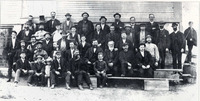 Thomas Emerson's Sons shop crew :circa 1868
Thomas Emerson's Sons shop crew :circa 1868 Thomas Emerson's Sons, manufacturers of gentleman's dress shoes, was located at the corner of Main Street and Yale Avenue. Born in 1785, founder Thomas Emerson was said to be "obliged from very early years to work at the bench" and is reported to have started his shoemaking in earnest in 1805. According to Lilley Eaton's Genealogical History of the Town of Reading, he formed a partnership with Ebenezer Nelson in 1810 for the manufacture of shoes, which "continued with a fair measure of success" until Nelson felt the calling to become a preacher and the business was amicably dissolved. Emerson was joined by his sons, Thomas, Jr. as a partner in 1837, and James Emerson in 1851 when the company became Thomas Emerson & Sons. The name was changed to Thomas Emerson's Sons, with the retirement of the founder in 1854. Originally located near Lawrence Street, the company moved to Albion Street and then to Yale Avenue/Main Street in 1863, the site formerly occupied by Burrage Yale's tin factory. The addition of the labor-saving McKay sewer required the expansion of the business and the enlargement of the factory. The Thomas Emerson's Sons factory closed in 1902, and the building was razed to make way for the YMCA. In Eaton's book, published in 1874, three years after Emerson's death, he was credited with inaugurating a system of cash payments to "workmen" in place of the customary barter system. "By the frequent introduction of improved machinery and methods, he was able to furnish profitable occupation to large numbers of people."
-
 Elias Boardman House :corner of Pleasant and Salem Streets, circa 1930
Elias Boardman House :corner of Pleasant and Salem Streets, circa 1930 The house at the corner of Salem and Pleasant Street is reported to have been built around 1820 by Elias Boardman, around the time of his marriage to Huldah Green, daughter of Reuben Green, a "respectful farmer" who lived on Greenwood Street. According to information submitted to the Massachusetts Historical Commission for the National Register of Historic Places, Elias was an architect, carpenter and builder who had worked on homes in the Beacon Hill section of Boston. Incorporated the open "high-style" typical of that area into his own home, unlike the simpler style found locally. As a result, it was considered to be extravagant and was dubbed open "Boardman's Folly." The submission also notes that "at one time, before indoor plumbing, the house had two owners, each of whom had title to 1/2 the house, 1/2 the yard, 1/2 the well, and 1/2 the back house." The Greek revival-style ell in the back was thought to have been built in the mid-19th century. The street was laid out in 1839 and the road from "Elias Boardman to E.S. Upham" was named Pleasant Street in 1847. The Boardman family was said to have owned the home for more than a century. Elias' grandson Arthur Boardman served as Town Treasurer in the 1920s and 1930s.
-
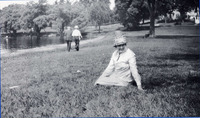 Wakefield Common :circa late 1920s
Wakefield Common :circa late 1920s Wakefield Park on the lower common has welcomed generations of Wakefield residents and others who spent many summer afternoons on the shores of Lake Quannapowitt. Catherine Kennedy Fitzgerald and her family were among those who enjoyed such an afternoon sometime around the late 1920s. Catherine and her husband, John F. Fitzgerald, were both born in Ireland and emigrated to the United States separately in the early 1900s. The couple and their five children: Eileen (Black), Rose (Day), John, Edward, and Bernard Fitzgerald, moved to Wakefield in 1924 where they lived on Broadway and later Emerson Street. The family has established deep roots within Wakefield, with several generations still residing in the community.
-
 Heywood-Wakefield, 50-year Employees
Heywood-Wakefield, 50-year Employees 50-year employees of the Heywood-Wakefield Company in 1928. Front row, from left: Andrew Anderson, Mary McCann, John Foley, Henry DeRoche. Back row, from left: Napoleon Munier, James Coleman, Patrick Maloney, Patrick Finneran, Cornelius O'Leary.
-
 Heywwood-Wakefield cabinet
Heywwood-Wakefield cabinet A cabinet made by the Heywood-Wakefield Company at its Wakefield, Massachusetts factory around the turn of the 20th century.
-
 Heywood-Wakefield showroom
Heywood-Wakefield showroom An early Heywood-Wakefield wicker furniture showroom - Wakefield, Massachusetts.
-
 Heywood-Wakefield showroom
Heywood-Wakefield showroom A furniture showroom at the Heywood-Wakefield Company - Wakefield, Masssachusetts, in the early 20th century.
-
 Heywood-Wakefield chair
Heywood-Wakefield chair An early wicker chair made by the Heywood-Wakefield Company.
-
 Rattan Furniture in truck
Rattan Furniture in truck A truck loaded with 250 chairs from the Wakefield rattan factory, driven by Paul DiDonato, Dec. 4, 1917.
Wakefield, Massachusetts.
-
 Heywood-Wakefield Chair
Heywood-Wakefield Chair An early wicker chair made by the Heywood-Wakefield Company, located in Wakefield , Massachusetts. From the early 20th century factory showroom.
-
 Cyrus Wakefield
Cyrus Wakefield Note that the identifications inscribed under the two Cyrus Wakefield photos are reversed. The first Cyrus Wakefield, the man who founded the Wakefield Rattan Company around 1855 and who lent his name to the town in 1868, is actually on the right. The man on the left is his nephew, Cyrus Wakefield II, who took over the company in 1873 following his uncle's death. The business eventually became the Heywood Brothers & Wakefield Company.
-
 Wakefield's Rattan Factory - 1866
Wakefield's Rattan Factory - 1866 The Wakefield Factory, around 1866.
-
 Wakefield Factory
Wakefield Factory Earliest known depiction of The Wakefield Factory, around 1856.
Founded by Cyrus Wakefield in what was then South Reading, Massachusetts, the business would eventually become the Heywood-Wakefield Company, one of the foremost furniture maufacturers in the country. South Reading changed its name to "Wakefield" in 1868, after Cyrus donated money and land for a new Town Hall.
-
 RattanMachineShop
RattanMachineShop An 1870 photo shows the rattan machine shop from east.
Wakefield, Massachusetts.
-
 Old Wakefield factory
Old Wakefield factory An 1865 view of WAKEFIELD'S RATTAN MANUFACTORY.
Founded by Cyrus Wakefield in what was then South Reading, Massachusetts, the business would eventually become the Heywood-Wakefield Company. South Reading changed its name to Wakefield in 1868, after Cyrus donated money and land for a new Town Hall.
-
 Hoogly
Hoogly An undated illustration of the "Wakefield Clipper Ship Hoogly discharging a cargo of rattans at Constitution Warf, Boston.
-
 Heywood-Wakefield Company
Heywood-Wakefield Company A load of rugs upon a horse-drawn truck outside the rattan factory in 1894. The driver is identified as Andy Dulong.
-
 Heywood-Wakefield workers
Heywood-Wakefield workers Workers at the Heywood-Wakefield rattan furniture factories in Wakefield, Massachusetts - 1897.
-
 RattanWood&MachineShop
RattanWood&MachineShop An 1880 exterior of the rattan wood and machine shop.
-
 Wakefield Factory
Wakefield Factory A view of the rattan factories from 1926.
-
 Wakefield rattan factories on Water St.
Wakefield rattan factories on Water St. A 1905 view from the east side of the Wakefield rattan factories, when Water St. ran through the factory yard. Land in foreground was once cow pasture and is now Nasella Park. The top of the Lincoln School can be seen in background, right.
-
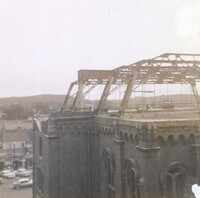 Town Hall Demolition - 1958
Town Hall Demolition - 1958 Wakefield, Massachusetts
-
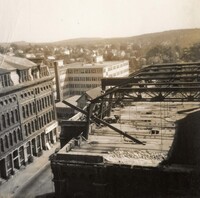 Town Hall Demolition - 1958
Town Hall Demolition - 1958 Wakefield, Massachusetts
-
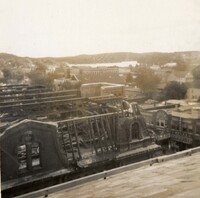 Town Hall Demolition - 1958
Town Hall Demolition - 1958 Wakefield, Massachusetts
-
 Town Hall Demolition - 1958
Town Hall Demolition - 1958 Wakefield, Massachusetts
-
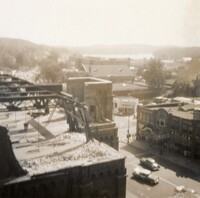 Town Hall Demolition - 1958
Town Hall Demolition - 1958 Wakefield, Massachusetts. The old Wakefield Cinema is on the right. Crystal Lake is visible in the background.
-
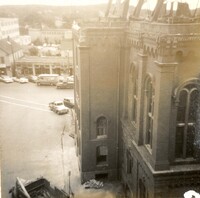 Town Hall Demolition - 1958
Town Hall Demolition - 1958 Wakefield, Massachusetts
-
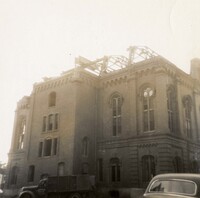 Town Hall Demolition - 1958
Town Hall Demolition - 1958 Wakefield, Massachusetts
-
 Town Hall Demolition - 1958
Town Hall Demolition - 1958 Wakefield, Massachusetts
-
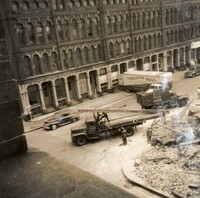 Town Hall Demolition - 1958
Town Hall Demolition - 1958 Wakefield, Massachusetts
-
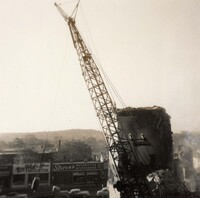 Town Hall Demolition - 1958
Town Hall Demolition - 1958 Wakefield, Massachusetts
-
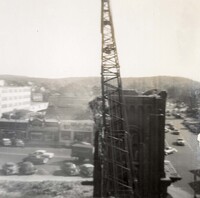 Town Hall Demolition - 1958
Town Hall Demolition - 1958 Wakefield, Massachusetts
-
 Town Hall Demolition - 1958
Town Hall Demolition - 1958 Wakefield, Massachusetts
-
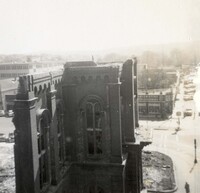 Town Hall Demolition - 1958
Town Hall Demolition - 1958 Wakefield, Massachusetts
-
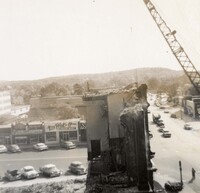 Town Hall Demolition - 1958
Town Hall Demolition - 1958 Wakefield, Massachusetts
 Lucius Beebe Memorial Library Art Brochure 2024 Explore the history behind the artwork on public display.
Lucius Beebe Memorial Library Art Brochure 2024 Explore the history behind the artwork on public display. Library Building - aerial view Aerial photograph of the library building and front plaza.
Library Building - aerial view Aerial photograph of the library building and front plaza. Front Door Photograph of the main street entrance.
Front Door Photograph of the main street entrance. Red Room - left Photograph of the Red Room's left side, facing the interior of the library building.
Red Room - left Photograph of the Red Room's left side, facing the interior of the library building. Red Room - right Photograph of the Red Room's right side, facing the front of the library building.
Red Room - right Photograph of the Red Room's right side, facing the front of the library building. Gold Room - right Photograph of the Gold Room / Living Room's right side, facing the fireplace and original external wall of the library building.
Gold Room - right Photograph of the Gold Room / Living Room's right side, facing the fireplace and original external wall of the library building. Gold Room - left Photograph of the Gold Room / Living Room's left side, facing the front of the library building.
Gold Room - left Photograph of the Gold Room / Living Room's left side, facing the front of the library building. Gold Room - entrance view (left) Photograph of the Gold Room / Living Room entrance view, facing left.
Gold Room - entrance view (left) Photograph of the Gold Room / Living Room entrance view, facing left. Gold Room - entrance view Photograph of the Gold Room / Living Room entrance view.
Gold Room - entrance view Photograph of the Gold Room / Living Room entrance view. Paperback Alcove Photograph of the romance/mystery paperback alcove, off the main lobby.
Paperback Alcove Photograph of the romance/mystery paperback alcove, off the main lobby. Lobby - facing alcove Photograph of the main lobby, facing the romance / mystery paperback alcove.
Lobby - facing alcove Photograph of the main lobby, facing the romance / mystery paperback alcove. Lobby bookshelf Photograph of a New Fiction bookshelf in the main lobby.
Lobby bookshelf Photograph of a New Fiction bookshelf in the main lobby. Lobby - facing Gold Room (2) Photograph of the main lobby, facing the Gold Room/Living Room door.
Lobby - facing Gold Room (2) Photograph of the main lobby, facing the Gold Room/Living Room door. Lobby - facing Gold Room Photograph of the main lobby, facing the Gold Room/Living Room door.
Lobby - facing Gold Room Photograph of the main lobby, facing the Gold Room/Living Room door. Lobby - facing Red Room (2) Photograph of the main lobby, facing the Red Room door.
Lobby - facing Red Room (2) Photograph of the main lobby, facing the Red Room door. Lobby - facing Red Room Photograph of the main lobby, facing the Red Room door.
Lobby - facing Red Room Photograph of the main lobby, facing the Red Room door. Lobby - facing front door Photograph of the main lobby, facing the front door.
Lobby - facing front door Photograph of the main lobby, facing the front door. "Bookplate Suggestions"
"Bookplate Suggestions"  "Franklin Poole Fund" bookplate Mirrored scan of the bookplate.
"Franklin Poole Fund" bookplate Mirrored scan of the bookplate. "Merrill Willis Gove Fund" bookplate
"Merrill Willis Gove Fund" bookplate  "John Gould Aborn Fund" bookplate Mirrored scan of the bookplate.
"John Gould Aborn Fund" bookplate Mirrored scan of the bookplate. "Cyrus Gilbert Beebe Library Fund" bookplate Mirrored scan of the bookplate.
"Cyrus Gilbert Beebe Library Fund" bookplate Mirrored scan of the bookplate. "Cyrus Wakefield Library Fund" bookplate Mirrored scan of the bookplate.
"Cyrus Wakefield Library Fund" bookplate Mirrored scan of the bookplate. Geo. E. Lambert Jr., Advertising Illustrations letter 01-10-1923
Geo. E. Lambert Jr., Advertising Illustrations letter 01-10-1923  "Junius Beebe Fund" hand-drawn bookplate template (back)
"Junius Beebe Fund" hand-drawn bookplate template (back)  "Junius Beebe Fund" hand-drawn bookplate template (front)
"Junius Beebe Fund" hand-drawn bookplate template (front)  "Junius Beebe Fund" bookplate print
"Junius Beebe Fund" bookplate print  "Books" bookplate
"Books" bookplate  Beebe Library bookplate
Beebe Library bookplate  Junius Beebe bookplate
Junius Beebe bookplate  Junius Beebe bookplate
Junius Beebe bookplate  Iron Works Sketch
Iron Works Sketch  Note Regarding Metal Plates
Note Regarding Metal Plates  Lawn Sign Sketch
Lawn Sign Sketch  Writing Table Sketch
Writing Table Sketch  "Schedule of Lamps"
"Schedule of Lamps"  "Orders to Contractor"
"Orders to Contractor"  "The Medallions"
"The Medallions"  Aerial view of Wakefield, 1948 This photo was taken by Cheyne Aerial Surveys of Methuen in 1948. According to the photo caption that appeared in the Boston Herald, "Take a good, long look at this suburban community, its main thoroughfare running from top left to right center of the picture, its athletic field at the bottom right, and two churches in the upper left corner. It's Wakefield from the air."
Aerial view of Wakefield, 1948 This photo was taken by Cheyne Aerial Surveys of Methuen in 1948. According to the photo caption that appeared in the Boston Herald, "Take a good, long look at this suburban community, its main thoroughfare running from top left to right center of the picture, its athletic field at the bottom right, and two churches in the upper left corner. It's Wakefield from the air." Stereograph of Lake Quannapowitt :circa 1880s This photograph is identified as having been taken by C.F. Richardson at Prospect and Elm Streets. In "Wakefield As It Is", a promotional booklet published by Chester W. Eaton's Real Estate Agency in 1880, the Boston Globe noted on May 2, 1880, "Eaton's real estate exchange reports an active demand for houses in the beautiful town of Wakefield., which is full of charming locations and various attractions. This agency, which is located at Wakefield, has houses and estates of every description ranging in price from $1,000 to $12,000 and building lots at reasonable figures. No suburban town is more popular for residential purposes than Wakefield, and its growth is sure and steady."
Stereograph of Lake Quannapowitt :circa 1880s This photograph is identified as having been taken by C.F. Richardson at Prospect and Elm Streets. In "Wakefield As It Is", a promotional booklet published by Chester W. Eaton's Real Estate Agency in 1880, the Boston Globe noted on May 2, 1880, "Eaton's real estate exchange reports an active demand for houses in the beautiful town of Wakefield., which is full of charming locations and various attractions. This agency, which is located at Wakefield, has houses and estates of every description ranging in price from $1,000 to $12,000 and building lots at reasonable figures. No suburban town is more popular for residential purposes than Wakefield, and its growth is sure and steady." G.W. Eaton, Grocers :Main Street, 1896 G.W. Eaton, Grocers was located at 394 Main Street from 1889 to 1917. Owned by George W. Eaton, a lifelong resident of Wakefield, the store sold a variety of items some of which were featured on advertisements on display at the store, including Quaker Oats; Bon Ami, a cleaner developed in 1886 by the J.T. Robertson Soap Company; products baked by the New York Pie Bakery, located in Massachusetts; chocolate and cocoa from the well-known chocolatier Walter Baker & Company of Dorchester; and smoking materials from J. G. Dill's Tobacco Company of Richmond, Virginia, a company which received four patents for chewing and smoking tobacco in 1878. The picture may have been taken in February 1896, as indicated by the 29 days on the calendar on the wall . It is interesting to note that the next leap year did not occur in 1900, rather it occurred in 1904. A leap year is every four years, but not every 100 years. Since 1752 in the United States, years exactly divisible by 100 are only leap years when they are also exactly divisible by 400. For example, 1800 and 1900 were not leap years, but 1700 and 2000 were. When Eaton retired in 1917 after 28 years in the grocery business, he disposed of his goods and closed the store, not selling the business to anyone else.
G.W. Eaton, Grocers :Main Street, 1896 G.W. Eaton, Grocers was located at 394 Main Street from 1889 to 1917. Owned by George W. Eaton, a lifelong resident of Wakefield, the store sold a variety of items some of which were featured on advertisements on display at the store, including Quaker Oats; Bon Ami, a cleaner developed in 1886 by the J.T. Robertson Soap Company; products baked by the New York Pie Bakery, located in Massachusetts; chocolate and cocoa from the well-known chocolatier Walter Baker & Company of Dorchester; and smoking materials from J. G. Dill's Tobacco Company of Richmond, Virginia, a company which received four patents for chewing and smoking tobacco in 1878. The picture may have been taken in February 1896, as indicated by the 29 days on the calendar on the wall . It is interesting to note that the next leap year did not occur in 1900, rather it occurred in 1904. A leap year is every four years, but not every 100 years. Since 1752 in the United States, years exactly divisible by 100 are only leap years when they are also exactly divisible by 400. For example, 1800 and 1900 were not leap years, but 1700 and 2000 were. When Eaton retired in 1917 after 28 years in the grocery business, he disposed of his goods and closed the store, not selling the business to anyone else. Wakefield High School Battalion Officers :1920-21 (Seated left to right) Captain Arthur Moncrieff, Captain Francis Bowman, Major Richard Dolbeare, Captain Roy Surrette and Captain Charles Carr. (Standing, left to right) 1st Lieut. Philip Pasqualino, 2nd Lieut. Winsor Finney, 1st Lieut. Frank DeFazio, 2nd Lieut. Myron Wing, Adj. A. Anderson, Battalion instructor Sergeant Ernest Monroe, 1st Lieut. Francis Walsh, 2nd Lieut. Abbott Fiendel, 1st Lieut. Cecil Ward, 2nd Lieutenant Robert Batten, and 1st Lieut. Samuel Levine. The Wakefield High School Battalion was created in October 1885, when the "boys of Wakefield High School" formed a military company and entered into the Second Massachusetts Regiment with cadets from Reading and Andover. During the 1920-21 school year, the Battalion was said to have "advanced farther" than in other years under the instruction of Sergeant Monroe of the United States Army. The battalion's four companies met for drill three periods each week, with an officers' school held every Tuesday afternoon to instruct the officers and non-commissioned officers. For several years, the companies which made up the Wakefield Battalion held spring prize drills in the Town Hall and later on the park (common). Due to crowded conditions at the High School and overcrowding of the program, military drills were abolished in 1931. The program was resumed with the entrance of the United States in World War II and was required of all boys in the junior and senior classes, as military training was valuable to the young men entering the service.
Wakefield High School Battalion Officers :1920-21 (Seated left to right) Captain Arthur Moncrieff, Captain Francis Bowman, Major Richard Dolbeare, Captain Roy Surrette and Captain Charles Carr. (Standing, left to right) 1st Lieut. Philip Pasqualino, 2nd Lieut. Winsor Finney, 1st Lieut. Frank DeFazio, 2nd Lieut. Myron Wing, Adj. A. Anderson, Battalion instructor Sergeant Ernest Monroe, 1st Lieut. Francis Walsh, 2nd Lieut. Abbott Fiendel, 1st Lieut. Cecil Ward, 2nd Lieutenant Robert Batten, and 1st Lieut. Samuel Levine. The Wakefield High School Battalion was created in October 1885, when the "boys of Wakefield High School" formed a military company and entered into the Second Massachusetts Regiment with cadets from Reading and Andover. During the 1920-21 school year, the Battalion was said to have "advanced farther" than in other years under the instruction of Sergeant Monroe of the United States Army. The battalion's four companies met for drill three periods each week, with an officers' school held every Tuesday afternoon to instruct the officers and non-commissioned officers. For several years, the companies which made up the Wakefield Battalion held spring prize drills in the Town Hall and later on the park (common). Due to crowded conditions at the High School and overcrowding of the program, military drills were abolished in 1931. The program was resumed with the entrance of the United States in World War II and was required of all boys in the junior and senior classes, as military training was valuable to the young men entering the service. Frederick Ballard Eaton House :Main Street near Sweetser Street, circa early 1900s Referred to as the Frederick Ballard Eaton House on Main Street near Sweetser Street, this home was reported to be occupied by Frederick's widow Eliza in Lilley Eaton's Genealogical History of Reading Mass., published in 1874. Frederick was born in Reading (now Wakefield) in May 1792, one of five children born to Samuel Eaton III and Sarah (Evans) Eaton. He married Eliza Vinton in 1815 and the two were parents of five children: Sarah, Henry, Mary, Hiram and Joseph. Sarah married George Reed Morrison, a Deacon in the First Parish Congregational Church and one of the first corporators of the Wakefield Savings Bank. Frederick died in 1858. It is not known when the house was built. The Frederick Ballard Eaton House is believed to be the house occupied by William Stimpson in 1812. According to Lilley Eaton's book, Stimson "was a bricklayer by trade, a peaceable, industrious, and honest man. He afterwards purchased and occupied the farm at the 'head of the pond', now or lately known as the 'Stimpson Farm'," probably the historic house now at 22 Prospect Street. Frederick Ballard Eaton built another house, the Greek Revival style home to the south of the original house, now 196 Main Street, for his son Hiram. A map of 1856 shows two Eaton houses at the corner of Main and Sweetser Streets.
Frederick Ballard Eaton House :Main Street near Sweetser Street, circa early 1900s Referred to as the Frederick Ballard Eaton House on Main Street near Sweetser Street, this home was reported to be occupied by Frederick's widow Eliza in Lilley Eaton's Genealogical History of Reading Mass., published in 1874. Frederick was born in Reading (now Wakefield) in May 1792, one of five children born to Samuel Eaton III and Sarah (Evans) Eaton. He married Eliza Vinton in 1815 and the two were parents of five children: Sarah, Henry, Mary, Hiram and Joseph. Sarah married George Reed Morrison, a Deacon in the First Parish Congregational Church and one of the first corporators of the Wakefield Savings Bank. Frederick died in 1858. It is not known when the house was built. The Frederick Ballard Eaton House is believed to be the house occupied by William Stimpson in 1812. According to Lilley Eaton's book, Stimson "was a bricklayer by trade, a peaceable, industrious, and honest man. He afterwards purchased and occupied the farm at the 'head of the pond', now or lately known as the 'Stimpson Farm'," probably the historic house now at 22 Prospect Street. Frederick Ballard Eaton built another house, the Greek Revival style home to the south of the original house, now 196 Main Street, for his son Hiram. A map of 1856 shows two Eaton houses at the corner of Main and Sweetser Streets. Kingman Block, 369 Main Street :September 1923 One of the oldest commercial buildings in downtown Wakefield, the Kingman Block, was built around 1860 during the tenure of Samuel Kingman, a tailor who later became Postmaster. Now known as the Bourdon Building, the building housed the Post Office until 1901 when it moved to the corner of Main Street and Richardson Avenue. During the late 1800s, Kingman's Hall was on one of the upper floors and was used for social parties and assemblies. The third floor was once the armory of the Richardson Light Guard, as well as the A.O.H. Hall and the Red Men's Hall. After the Post Office vacated the building, the bottom floor of the building was altered over the years to accommodate many businesses, including Wilhelmina's Smart Shop, O'Connor's Men's Shop, and Wm. M. Deadman's Market which was on the Albion Street side of the building. Kenwood's Lunch was the occupant of the first floor when this picture was taken on September 21, 1923 just before the razing of the Bessey Livery Stables pictured on the right. Kenwood Lunch advertised that it was an American restaurant with American food and management and encouraged readers to "come and enjoy a real good meal. We solicit your patronage and guarantee satisfaction." The Willard Service Station, the taxi office of Richard Barrett, and the Victor Shoe Shine Parlor, to the right of the Kingman Building were also razed in November 1923 in preparation for the Wakefield Trust Company building.
Kingman Block, 369 Main Street :September 1923 One of the oldest commercial buildings in downtown Wakefield, the Kingman Block, was built around 1860 during the tenure of Samuel Kingman, a tailor who later became Postmaster. Now known as the Bourdon Building, the building housed the Post Office until 1901 when it moved to the corner of Main Street and Richardson Avenue. During the late 1800s, Kingman's Hall was on one of the upper floors and was used for social parties and assemblies. The third floor was once the armory of the Richardson Light Guard, as well as the A.O.H. Hall and the Red Men's Hall. After the Post Office vacated the building, the bottom floor of the building was altered over the years to accommodate many businesses, including Wilhelmina's Smart Shop, O'Connor's Men's Shop, and Wm. M. Deadman's Market which was on the Albion Street side of the building. Kenwood's Lunch was the occupant of the first floor when this picture was taken on September 21, 1923 just before the razing of the Bessey Livery Stables pictured on the right. Kenwood Lunch advertised that it was an American restaurant with American food and management and encouraged readers to "come and enjoy a real good meal. We solicit your patronage and guarantee satisfaction." The Willard Service Station, the taxi office of Richard Barrett, and the Victor Shoe Shine Parlor, to the right of the Kingman Building were also razed in November 1923 in preparation for the Wakefield Trust Company building. Company A leaving for Camp Devens :World War I, August 1917 Company A, Sixth Regiment of the Richardson Light Guard, was mustered into service on April 6, 1917. Less than 12 hours later, Company A was on its way to Fort Revere in Hull. On August 25th, the company was allowed to return home for a day before being sent to war. A farewell parade was held on Sunday which started at the Armory (now the Americal Civic Center) and ended at the Upper Train Station. According to Wakefield Massachusetts in the World War 1917- 1920, a book started by Emma Florence Eaton (who worked on the project from 1919-1921), and completed in 1935 under a W.P.A. project, more than 900 Wakefield men and women were enrolled in the various branches of the service. A total of 41 gave their lives to the cause, 97 were "gassed" or wounded, 27 received "decorations for valor," and 37 were cited for gallantry in action when the war ended in 1919. Pictured after the company passed through the town during the 1917 farewell parade, thousands of local residents returned to their homes or walked or rode to the train station for the final good-bye. It is interesting to note that the sign in the foreground reminds drivers to "keep to the right. Please observe the law." It is also important to not only note the dress on what was probably a hot August day, but to also note the cars, one of which has the steering wheel on the right.
Company A leaving for Camp Devens :World War I, August 1917 Company A, Sixth Regiment of the Richardson Light Guard, was mustered into service on April 6, 1917. Less than 12 hours later, Company A was on its way to Fort Revere in Hull. On August 25th, the company was allowed to return home for a day before being sent to war. A farewell parade was held on Sunday which started at the Armory (now the Americal Civic Center) and ended at the Upper Train Station. According to Wakefield Massachusetts in the World War 1917- 1920, a book started by Emma Florence Eaton (who worked on the project from 1919-1921), and completed in 1935 under a W.P.A. project, more than 900 Wakefield men and women were enrolled in the various branches of the service. A total of 41 gave their lives to the cause, 97 were "gassed" or wounded, 27 received "decorations for valor," and 37 were cited for gallantry in action when the war ended in 1919. Pictured after the company passed through the town during the 1917 farewell parade, thousands of local residents returned to their homes or walked or rode to the train station for the final good-bye. It is interesting to note that the sign in the foreground reminds drivers to "keep to the right. Please observe the law." It is also important to not only note the dress on what was probably a hot August day, but to also note the cars, one of which has the steering wheel on the right. Fourth of July celebration, 1957 The annual Fourth of July celebration, sponsored by the West Side Social Club, featured children's activities and contests, a three-division parade which began at Moulton Playground and ended at the Common, a band concert, and fireworks. The parade, the largest in the events history, stepped off at 2 p.m. on a route that traveled along Albion, Gould, Walnut and Chestnut Streets, North Avenue, Main and Church Streets. Several of the children's activities, including the fishing derby, home run hitting contest, pet "show", and a boys-only bicycle, tricycle and cart parade were held the night before, beginning at 6:30 p.m., followed by a band concert, variety show featuring three vaudeville acts and a "sample" fireworks display. The remaining children's events, including the children's races and doll carriage parade were held on the morning of July 4th, some of which were featured on WBZ-TV's live broadcast from 11 a.m. to 1 p.m. and on Bob Emery's Big Brother show. The parade floats which "appeared in the line of march" in the afternoon "assembled for a trip before the cameras on Church Street in front of the bandstand and several marching groups also were shown at 11 o'clock." Brian Goss, on the bicycle was the second-place winner in the bicycle parade, which won him a "crest lite." He and his mother, Ruth, are pictured with what may be the other winners who were reported to have been interviewed by Bob Emery on his show.
Fourth of July celebration, 1957 The annual Fourth of July celebration, sponsored by the West Side Social Club, featured children's activities and contests, a three-division parade which began at Moulton Playground and ended at the Common, a band concert, and fireworks. The parade, the largest in the events history, stepped off at 2 p.m. on a route that traveled along Albion, Gould, Walnut and Chestnut Streets, North Avenue, Main and Church Streets. Several of the children's activities, including the fishing derby, home run hitting contest, pet "show", and a boys-only bicycle, tricycle and cart parade were held the night before, beginning at 6:30 p.m., followed by a band concert, variety show featuring three vaudeville acts and a "sample" fireworks display. The remaining children's events, including the children's races and doll carriage parade were held on the morning of July 4th, some of which were featured on WBZ-TV's live broadcast from 11 a.m. to 1 p.m. and on Bob Emery's Big Brother show. The parade floats which "appeared in the line of march" in the afternoon "assembled for a trip before the cameras on Church Street in front of the bandstand and several marching groups also were shown at 11 o'clock." Brian Goss, on the bicycle was the second-place winner in the bicycle parade, which won him a "crest lite." He and his mother, Ruth, are pictured with what may be the other winners who were reported to have been interviewed by Bob Emery on his show. Building of Clipper Cove, Pleasure Island :June 5, 1959 According to the photo caption on the back of the photo, "PIRATE HIDEOUT - Shipfitters set the rigging on a pair of pirate boats moored to the wharf on the shore of Pleasure Island's currently calm inland sea." The photo was taken just weeks before the June 22nd public opening of the park. The designers and construction crews were able to turn swampland into the Disney of the East in less than one year, starting earth-moving operations in the Fall of 1958, working through a New England winter and above average rainfall amounts during the 1959 spring and summer. This photo shows portions of the park's main themed areas, Clipper Cove, on the left, and the Western section called Goldpan Gulch, above right. Clipper Cove was designed to represent a New England seaport from the mid-1800s. It incorporated the Pirate Cove and Moby Dick attractions as well as the Wreck of the Hesperus dark ride. The Western section featured the narrow-gauge steam train "Old Smokey" and the Goldpan Gulch Station, the Diamond Lil Saloon, Quannapowitt Publishers Print Shop, the Chisholm Trail dark ride, and an 1800s and Contemporary Hotel exhibit by Hotel Corporation of America. At the top of Clipper Cove (left to right) is the Hotel Exhibit, the dark ride, Print Shop, and Saloon. Facing Clipper Cove at the rear of the Hotel Exhibit was the Sheriff's Office and Jail. Across from this complex was the popular Tilt House, often referred to as the Slanty Shanty. On the left beyond the launch platform for the Pirate Cove attraction was Cap'n Snow's Chowder House, which was still under construction. Several other attractions also opened in the park's first season, some survived for the entire 11 seasons while others were either added or removed, including the park's shops and dining facilities. This year also marks the 50th anniversary of Pleasure Island's 11th and final season. Wakefield hosted the second of three theme parks built across America after Disneyland and although long gone, Edgewater Office Park maintains much of the past landscape and water features enjoyed by the millions of former guests, young and old.
Building of Clipper Cove, Pleasure Island :June 5, 1959 According to the photo caption on the back of the photo, "PIRATE HIDEOUT - Shipfitters set the rigging on a pair of pirate boats moored to the wharf on the shore of Pleasure Island's currently calm inland sea." The photo was taken just weeks before the June 22nd public opening of the park. The designers and construction crews were able to turn swampland into the Disney of the East in less than one year, starting earth-moving operations in the Fall of 1958, working through a New England winter and above average rainfall amounts during the 1959 spring and summer. This photo shows portions of the park's main themed areas, Clipper Cove, on the left, and the Western section called Goldpan Gulch, above right. Clipper Cove was designed to represent a New England seaport from the mid-1800s. It incorporated the Pirate Cove and Moby Dick attractions as well as the Wreck of the Hesperus dark ride. The Western section featured the narrow-gauge steam train "Old Smokey" and the Goldpan Gulch Station, the Diamond Lil Saloon, Quannapowitt Publishers Print Shop, the Chisholm Trail dark ride, and an 1800s and Contemporary Hotel exhibit by Hotel Corporation of America. At the top of Clipper Cove (left to right) is the Hotel Exhibit, the dark ride, Print Shop, and Saloon. Facing Clipper Cove at the rear of the Hotel Exhibit was the Sheriff's Office and Jail. Across from this complex was the popular Tilt House, often referred to as the Slanty Shanty. On the left beyond the launch platform for the Pirate Cove attraction was Cap'n Snow's Chowder House, which was still under construction. Several other attractions also opened in the park's first season, some survived for the entire 11 seasons while others were either added or removed, including the park's shops and dining facilities. This year also marks the 50th anniversary of Pleasure Island's 11th and final season. Wakefield hosted the second of three theme parks built across America after Disneyland and although long gone, Edgewater Office Park maintains much of the past landscape and water features enjoyed by the millions of former guests, young and old. Wakefield Clothing Company :390 Main Street, circa 1923 This building, occupied by the Wakefield Clothing Company in 1923, once numbered as 390 Main Street, was located across from Avon Street. While most prominent buildings in downtown Wakefield were often referred to by either the name of their builders or occupants, this building is not as identifiable. It could have been called the Daland Building in the late 1800s, as it was owned and occupied at the time by the Everett G. Daland Dry Goods Store. The store measured 75' x 20' and provided a "large and fine assortment of dry goods, children's clothing, men's furnishings, hats and various small wares too numerous to mention." It is reported that Everett George Daland, a Wakefield native, opened the dry goods store in 1878 at the age of 18. He opened the store for 23 years and went on to work as a traveling salesman for Simon, Hatch and Whitten Company of Boston, a wholesale men's furnishings company for the next 30 years. The building itself is similar to, and often mistaken for, the Butler block which is located on Main Street across from Albion Street.
Wakefield Clothing Company :390 Main Street, circa 1923 This building, occupied by the Wakefield Clothing Company in 1923, once numbered as 390 Main Street, was located across from Avon Street. While most prominent buildings in downtown Wakefield were often referred to by either the name of their builders or occupants, this building is not as identifiable. It could have been called the Daland Building in the late 1800s, as it was owned and occupied at the time by the Everett G. Daland Dry Goods Store. The store measured 75' x 20' and provided a "large and fine assortment of dry goods, children's clothing, men's furnishings, hats and various small wares too numerous to mention." It is reported that Everett George Daland, a Wakefield native, opened the dry goods store in 1878 at the age of 18. He opened the store for 23 years and went on to work as a traveling salesman for Simon, Hatch and Whitten Company of Boston, a wholesale men's furnishings company for the next 30 years. The building itself is similar to, and often mistaken for, the Butler block which is located on Main Street across from Albion Street. Emerson Homestead :Lawrence and Main Streets, circa 1906 Although there were several houses owned and occupied by members of the Emerson family, this is probably the home of Thomas Emerson, founder of Thomas Emerson & Sons at the corner of Main and Lawrence Streets. According to the Historic Homes and Places and Genealogical and Personal Memoirs Relating to the Families of Middlesex County, Massachusetts published in 1906, Emerson was born in 1785 and died in 1871. He and his wife Elizabeth Hartshorn, said to be the sister of Col. James Hartshorn, were the parents of five children: Thomas, Augusta, Sarah, Maria and James. James, the youngest, is the only child listed as being born in the home in 1830. Thomas Emerson was credited with instituting a system of paying wages in cash instead of "barter at the store," once a practice of shoe manufacturers. A Selectman, member of the School Committee, Representative to the General Court and a State Senator, the elder Thomas was one of the "most prominent citizens and business men active in political affairs" with a "charming personality and sterling character," traits carried on by his two sons, Thomas and James, both of whom are credited with growing the business in "volume and prosperity" and continuing his community and civic service. After their father's retirement in 1854, his two sons renamed the company Thomas Emerson's Sons. The younger Thomas was one of the founders of the Wakefield Horticultural and Agricultural Society, and although he was an integral part of Thomas Emerson's Sons, he also served as President of the Mechanic and Agricultural Institution, a bank, for 24 years, and as a trustee of the Wakefield Savings Bank and director of the National Bank, along with many other organizations. James Emerson followed his father's civic sense of duty as Town Treasurer for 28 years. He is credited as being a "leading spirit in the organization" of the Richard [i.e. Richardson] Light Guard, serving as Commander of the company, was the second President of the Wakefield Savings Bank, and was an organizer and charter member of the Wakefield Home for Aged Women (the Boit Home.) He played a "prominent role" in bringing water, electricity and gas to the town, and in acquiring land bordering Lake Quannapowitt for use as a public park. He died in the family home in 1906.
Emerson Homestead :Lawrence and Main Streets, circa 1906 Although there were several houses owned and occupied by members of the Emerson family, this is probably the home of Thomas Emerson, founder of Thomas Emerson & Sons at the corner of Main and Lawrence Streets. According to the Historic Homes and Places and Genealogical and Personal Memoirs Relating to the Families of Middlesex County, Massachusetts published in 1906, Emerson was born in 1785 and died in 1871. He and his wife Elizabeth Hartshorn, said to be the sister of Col. James Hartshorn, were the parents of five children: Thomas, Augusta, Sarah, Maria and James. James, the youngest, is the only child listed as being born in the home in 1830. Thomas Emerson was credited with instituting a system of paying wages in cash instead of "barter at the store," once a practice of shoe manufacturers. A Selectman, member of the School Committee, Representative to the General Court and a State Senator, the elder Thomas was one of the "most prominent citizens and business men active in political affairs" with a "charming personality and sterling character," traits carried on by his two sons, Thomas and James, both of whom are credited with growing the business in "volume and prosperity" and continuing his community and civic service. After their father's retirement in 1854, his two sons renamed the company Thomas Emerson's Sons. The younger Thomas was one of the founders of the Wakefield Horticultural and Agricultural Society, and although he was an integral part of Thomas Emerson's Sons, he also served as President of the Mechanic and Agricultural Institution, a bank, for 24 years, and as a trustee of the Wakefield Savings Bank and director of the National Bank, along with many other organizations. James Emerson followed his father's civic sense of duty as Town Treasurer for 28 years. He is credited as being a "leading spirit in the organization" of the Richard [i.e. Richardson] Light Guard, serving as Commander of the company, was the second President of the Wakefield Savings Bank, and was an organizer and charter member of the Wakefield Home for Aged Women (the Boit Home.) He played a "prominent role" in bringing water, electricity and gas to the town, and in acquiring land bordering Lake Quannapowitt for use as a public park. He died in the family home in 1906. L.B. Evans, Water Street, circa 1942 The building at 29 Water Street, former home to L.B. Evans Son Co. Shoe Manufacturers, was built as a three-story, 60' by 40' building in 1894. Founded in 1841 by Lucius Bolles Evans in a building at the at the rear of a dwelling house at 9 Salem Street, the shoe manufacturing shop moved to 8 Salem Street in 1884. In 1894, Lucius' son, Harvey B. Evans built the new shoemaking factory on the site formerly occupied by the Episcopal Church, employing 80 people.The company was incorporated as the L.B. Evans' Son Company in 1905 by Harvey Evans' sons following his death. A 40' addition and a fourth story were added somewhere around 1904, with many other additions made over the years, bringing the total square footage to 117,000 sq. ft when the final addition was completed in the late 1960s. Once recognized as the oldest shoe manufacturing concern in the United States and the oldest industry in Wakefield, the company and its building were purchased by a Fitchburg Company in 1979 and the company began to be phased out in 1980, eventually closing around 1987. The company was best known for its slippers and casual shoes in its later years. Although it appeared that the Burche Manufacturing Company was located in the L.B. Evans building, the angle of this photograph made it appear that the company's sign was on the building, according to a press statement on the back of the photograph.
L.B. Evans, Water Street, circa 1942 The building at 29 Water Street, former home to L.B. Evans Son Co. Shoe Manufacturers, was built as a three-story, 60' by 40' building in 1894. Founded in 1841 by Lucius Bolles Evans in a building at the at the rear of a dwelling house at 9 Salem Street, the shoe manufacturing shop moved to 8 Salem Street in 1884. In 1894, Lucius' son, Harvey B. Evans built the new shoemaking factory on the site formerly occupied by the Episcopal Church, employing 80 people.The company was incorporated as the L.B. Evans' Son Company in 1905 by Harvey Evans' sons following his death. A 40' addition and a fourth story were added somewhere around 1904, with many other additions made over the years, bringing the total square footage to 117,000 sq. ft when the final addition was completed in the late 1960s. Once recognized as the oldest shoe manufacturing concern in the United States and the oldest industry in Wakefield, the company and its building were purchased by a Fitchburg Company in 1979 and the company began to be phased out in 1980, eventually closing around 1987. The company was best known for its slippers and casual shoes in its later years. Although it appeared that the Burche Manufacturing Company was located in the L.B. Evans building, the angle of this photograph made it appear that the company's sign was on the building, according to a press statement on the back of the photograph. Ice harvesting :circa late 1880s Frederick Tudor, a prominent Boston merchant referred to as the "Ice King of New England" in the early 19th century began harvesting ice from ponds and lakes across Massachusetts beginning in 1805. He harvested ice from both Lake Quannapowitt and Crystal Lake, as well as several other area lakes and ponds, that were shipped to areas as far south as Charleston and New Orleans, and as far as the West Indies. Ice harvesting in Wakefield increased with the creation of the Quannapowitt Railroad Company in 1849 to transport ice from storage to the main railroad and to points beyond. By 1855, 27,000 tons of ice were harvested from both Lake Quannapowitt and Crystal Lake for an estimated value of $13,500, employing 20 men, making the town the fourth largest source of commercial ice in Middlesex County. In its heyday, there were more than three dozen ice houses operating at one time: the 24-ice house Boston Ice Company, the People's Ice Company, the Whipple-Morrill Company, Morrill-Atwood Company, and the Nichols Ice Company, all on Lake Quannapowitt; and three on Crystal Lake: the Philpott houses near the "Greenwood Bridge", a "set of houses" on [sic] at the corner of Crystal Lake Park near the Town nursery, and another on the east shore near the Junction railroad station. The picture shows the workers getting the cut ice into the ice house. According to Alonzo Colson's accounts published in the Wakefield Daily Item in 1947 and 1948, the connecting links between the ice houses and the "ice fields" were called runs, which were two 100-foot platforms of heavy boards, each five feet apart, five feet wide and two feet above the water. The ice cakes would float between them and long chains would go down into the water to pick up the cakes that workers had "poled" along and put on the chains, which were two "flat-faced" link chains five feet apart and seven to eight inches long. A hardwood cross bar connected the two chains which picked up the ice cake from the "submerged big wheels upon which it rolled." The ice was then slid onto iron tracks to the desired storage level.
Ice harvesting :circa late 1880s Frederick Tudor, a prominent Boston merchant referred to as the "Ice King of New England" in the early 19th century began harvesting ice from ponds and lakes across Massachusetts beginning in 1805. He harvested ice from both Lake Quannapowitt and Crystal Lake, as well as several other area lakes and ponds, that were shipped to areas as far south as Charleston and New Orleans, and as far as the West Indies. Ice harvesting in Wakefield increased with the creation of the Quannapowitt Railroad Company in 1849 to transport ice from storage to the main railroad and to points beyond. By 1855, 27,000 tons of ice were harvested from both Lake Quannapowitt and Crystal Lake for an estimated value of $13,500, employing 20 men, making the town the fourth largest source of commercial ice in Middlesex County. In its heyday, there were more than three dozen ice houses operating at one time: the 24-ice house Boston Ice Company, the People's Ice Company, the Whipple-Morrill Company, Morrill-Atwood Company, and the Nichols Ice Company, all on Lake Quannapowitt; and three on Crystal Lake: the Philpott houses near the "Greenwood Bridge", a "set of houses" on [sic] at the corner of Crystal Lake Park near the Town nursery, and another on the east shore near the Junction railroad station. The picture shows the workers getting the cut ice into the ice house. According to Alonzo Colson's accounts published in the Wakefield Daily Item in 1947 and 1948, the connecting links between the ice houses and the "ice fields" were called runs, which were two 100-foot platforms of heavy boards, each five feet apart, five feet wide and two feet above the water. The ice cakes would float between them and long chains would go down into the water to pick up the cakes that workers had "poled" along and put on the chains, which were two "flat-faced" link chains five feet apart and seven to eight inches long. A hardwood cross bar connected the two chains which picked up the ice cake from the "submerged big wheels upon which it rolled." The ice was then slid onto iron tracks to the desired storage level. Boothby's Specialty Shop :432-434 Main Street, circa 1920s Boothby's Specialty Shop began as Boothby's Beehive when Asa and Mabel Boothby purchased The Emerson, a dry goods store owned by Bernice Emerson across the street in the Traders' Block, in 1907. Daily operations were handled by Mabel while Asa worked as a salesman, and later as sales manager, for Wadsworth-Howland Co. The store moved across the street into the Butler Block, then numbered 432-434 Main Street, in 1919 in a store previously occupied by Butler's variety store and, with the addition of more merchandise, became a women's specialty store. The couple purchased the building from the estate of Aaron Butler in 1923 and remodeled it in 1936 by adding a 75' one-story addition in the rear, removing the yarn shop on the second floor and adding four kitchenette apartments. Both Asa and Mabel Boothby were active in the community; he as a Selectman, Chairman of the Salvage Committee during World War II, and as an officer of several professional, civic and religious organizations; and she as Noble Grand of Goodwill Rebekah Lodge, No.22, I.O.O.F, and as an officer of other civic and religious organizations. The business was sold to W.T. Grant Company Manager Leslie Gaquin in 1944, who also purchased in the building in 1946.
Boothby's Specialty Shop :432-434 Main Street, circa 1920s Boothby's Specialty Shop began as Boothby's Beehive when Asa and Mabel Boothby purchased The Emerson, a dry goods store owned by Bernice Emerson across the street in the Traders' Block, in 1907. Daily operations were handled by Mabel while Asa worked as a salesman, and later as sales manager, for Wadsworth-Howland Co. The store moved across the street into the Butler Block, then numbered 432-434 Main Street, in 1919 in a store previously occupied by Butler's variety store and, with the addition of more merchandise, became a women's specialty store. The couple purchased the building from the estate of Aaron Butler in 1923 and remodeled it in 1936 by adding a 75' one-story addition in the rear, removing the yarn shop on the second floor and adding four kitchenette apartments. Both Asa and Mabel Boothby were active in the community; he as a Selectman, Chairman of the Salvage Committee during World War II, and as an officer of several professional, civic and religious organizations; and she as Noble Grand of Goodwill Rebekah Lodge, No.22, I.O.O.F, and as an officer of other civic and religious organizations. The business was sold to W.T. Grant Company Manager Leslie Gaquin in 1944, who also purchased in the building in 1946. First Baptist Church, 1872 The stately First Baptist Church was destroyed by a seven-alarm fire on October 23, 2018. The church is described in the 250th anniversary publication of 1894, after addressing a fire that destroyed its second house of worship in 1871, as follows: "The people had already felt the need of more ample accommodations, and, with strong hope and courage, secured a lot of land on the corner of Main and Lafayette Streets, where the foundations of worship were laid. This structure, which is no exception to the unwritten law that calls for attractive public buildings in the town, was dedicated (on) Dec. 11, 1872. Built of wood, it belongs to the Romanesque order, with minaret and lofty spire, one hundred and eighty feet from the base. the spacious auditorium was designed for one thousand people".
First Baptist Church, 1872 The stately First Baptist Church was destroyed by a seven-alarm fire on October 23, 2018. The church is described in the 250th anniversary publication of 1894, after addressing a fire that destroyed its second house of worship in 1871, as follows: "The people had already felt the need of more ample accommodations, and, with strong hope and courage, secured a lot of land on the corner of Main and Lafayette Streets, where the foundations of worship were laid. This structure, which is no exception to the unwritten law that calls for attractive public buildings in the town, was dedicated (on) Dec. 11, 1872. Built of wood, it belongs to the Romanesque order, with minaret and lofty spire, one hundred and eighty feet from the base. the spacious auditorium was designed for one thousand people". Wakefield Square :circa 1980s Image from the Wakefield Municipal Gas and Light Department annual calendar, 2021
Wakefield Square :circa 1980s Image from the Wakefield Municipal Gas and Light Department annual calendar, 2021 Greenwood gathering :circa 1930 The other half of the Greenwood gathering appearing elsewhere in this calendar features a glimpse at some of the local businesses that exhibited their wares at the circa 1930 gathering in Greenwood. H.S. Sorensen, a local jeweler, is in the center, and on the right is the display of the J. Wallace Grace Hardware Company, a hardware and plumbing store that was located at 14 Albion Street and started in business in the mid-1800s. The store may have been associated with the International Oil Burner display, at right, which touted the new type oil burner that, according to industry publications, "took the place of wood or coal and automatically and silently changes cheap oil into one of the quickest and hottest fires known." It was said to burn 96% air and 4% "cheap oil" and fit in the fire box of any range, stove or furnace. George Archibald is also in this part of the picture, wearing a sweater, knickers and striped socks, standing alone with his left hand touching his face.
Greenwood gathering :circa 1930 The other half of the Greenwood gathering appearing elsewhere in this calendar features a glimpse at some of the local businesses that exhibited their wares at the circa 1930 gathering in Greenwood. H.S. Sorensen, a local jeweler, is in the center, and on the right is the display of the J. Wallace Grace Hardware Company, a hardware and plumbing store that was located at 14 Albion Street and started in business in the mid-1800s. The store may have been associated with the International Oil Burner display, at right, which touted the new type oil burner that, according to industry publications, "took the place of wood or coal and automatically and silently changes cheap oil into one of the quickest and hottest fires known." It was said to burn 96% air and 4% "cheap oil" and fit in the fire box of any range, stove or furnace. George Archibald is also in this part of the picture, wearing a sweater, knickers and striped socks, standing alone with his left hand touching his face. Crescent and Eaton Streets :1930 This photograph was taken from the steeple of the Baptist Church, looking southeast. The view shows several prominent buildings and structures, most notably the Unitarian-Universalist Church of Wakefield, at the right, the factory building once referred to as the "Old Rink Building" and former home to the Richardson Light Guard armory, the Lincoln School, and the Heywood-Wakefield Company, formerly the Wakefield Rattan Company, and later the Robie Industrial Park. The photograph was taken before the 1951 police station was built, now part of the Public Safety Building. The 1900 fire station is not pictured but is to the right of the top of the church steeple. Note the homes with barns and the absence of automobiles in the driveways and on the roadways.
Crescent and Eaton Streets :1930 This photograph was taken from the steeple of the Baptist Church, looking southeast. The view shows several prominent buildings and structures, most notably the Unitarian-Universalist Church of Wakefield, at the right, the factory building once referred to as the "Old Rink Building" and former home to the Richardson Light Guard armory, the Lincoln School, and the Heywood-Wakefield Company, formerly the Wakefield Rattan Company, and later the Robie Industrial Park. The photograph was taken before the 1951 police station was built, now part of the Public Safety Building. The 1900 fire station is not pictured but is to the right of the top of the church steeple. Note the homes with barns and the absence of automobiles in the driveways and on the roadways. Veteran Firemen's Association :Crescent Street, opposite Mechanic Street, circa 1890s Wakefield's Veteran Firemen's Association appears to have been among the most active of the veteran firemen's organizations in the Commonwealth in the late 1890s. Comprised of "old-time firemen," the members of the association took part in numerous balls, parades, and competitions organized by the New England States Veterans Firemen's League in the 1880s and 1890s. The Veteran Firemen's Association was organized in January 1889 with 45 charter members. Early officers included President W.A. Cutter, Vice President E.H. Walton, Secretary George Weston, Treasurer E.E. Whiton, and Foreman Alexander Flanders. The April 1889 Town Meeting approved the use and custody of the Yale Engine No. 1 to the group, later selling it to them for $1 in November 1891, with the condition that the hand tub be kept in good condition for use at all fires, and "subject to duty whenever required by the Fire Engineers of Wakefield." The engine could not be sold without the consent of the Town and would revert back to the Town when the company disbanded. During one outing in Boston in September 1892, the Wakefield group was among more than 3,000 uniformed members representing 25 companies and 23 engines, some of which were hailed as the "best in the nation." The competitions included engine tests with Wakefield's Yale Engine coming in third with a horizontal stream of 205', 2.75". The Yale, named after noted citizen and benefactor Burrage Yale, was destroyed in a fire at the Central Fire Station in 1899. the association participated in the Town's 250th anniversary celebration in 1894, which may be the occasion for the photograph. Note the Yale name on the belt buckles.
Veteran Firemen's Association :Crescent Street, opposite Mechanic Street, circa 1890s Wakefield's Veteran Firemen's Association appears to have been among the most active of the veteran firemen's organizations in the Commonwealth in the late 1890s. Comprised of "old-time firemen," the members of the association took part in numerous balls, parades, and competitions organized by the New England States Veterans Firemen's League in the 1880s and 1890s. The Veteran Firemen's Association was organized in January 1889 with 45 charter members. Early officers included President W.A. Cutter, Vice President E.H. Walton, Secretary George Weston, Treasurer E.E. Whiton, and Foreman Alexander Flanders. The April 1889 Town Meeting approved the use and custody of the Yale Engine No. 1 to the group, later selling it to them for $1 in November 1891, with the condition that the hand tub be kept in good condition for use at all fires, and "subject to duty whenever required by the Fire Engineers of Wakefield." The engine could not be sold without the consent of the Town and would revert back to the Town when the company disbanded. During one outing in Boston in September 1892, the Wakefield group was among more than 3,000 uniformed members representing 25 companies and 23 engines, some of which were hailed as the "best in the nation." The competitions included engine tests with Wakefield's Yale Engine coming in third with a horizontal stream of 205', 2.75". The Yale, named after noted citizen and benefactor Burrage Yale, was destroyed in a fire at the Central Fire Station in 1899. the association participated in the Town's 250th anniversary celebration in 1894, which may be the occasion for the photograph. Note the Yale name on the belt buckles. Greenwood Branch Library :1934 The Greenwood Branch of the Beebe Town Library opened in October 1904 at the "new" Greenwood School building. According to the 1904 Town Report, the library started as a twice-weekly delivery "by an attendant" to Greenwood residents. By February 1905, 876 books had been circulated and 60 "application" cards had been requested. The Greenwood Branch Library was open on Mondays and Thursdays from 3:30 p.m. to 5 p.m., and in January 1906 its hours were expanded to include Saturday evenings from 7 p.m. to 8 p.m. The library branch was so popular that the Saturday hours were increased to 6:30 p.m. to 8:30 p.m. and a room in the school was eventually dedicated to library operations on Mondays, Thursdays and Saturday, a schedule that remained in place for decades. During the early 1930s, improvements were made to the Greenwood Branch Library under the direction of Librarian Clara Wilson. The 1933 Town Report describes the library rooms as "inviting and homelike and are taking on a real place in community life. Decorations suitable to the various seasons are arranged and there is always some scene in the glass case of interest to both children and grown-ups." In 1962, the library rooms were needed for classrooms, and the branch library was moved to smaller space within the school. The branch closed in September with its books stored in the basement until its new home was finished in "conjunction" with the Greenwood Fire Station. The Greenwood Branch Library officially opened in its new home in the station on May 5, 1963.
Greenwood Branch Library :1934 The Greenwood Branch of the Beebe Town Library opened in October 1904 at the "new" Greenwood School building. According to the 1904 Town Report, the library started as a twice-weekly delivery "by an attendant" to Greenwood residents. By February 1905, 876 books had been circulated and 60 "application" cards had been requested. The Greenwood Branch Library was open on Mondays and Thursdays from 3:30 p.m. to 5 p.m., and in January 1906 its hours were expanded to include Saturday evenings from 7 p.m. to 8 p.m. The library branch was so popular that the Saturday hours were increased to 6:30 p.m. to 8:30 p.m. and a room in the school was eventually dedicated to library operations on Mondays, Thursdays and Saturday, a schedule that remained in place for decades. During the early 1930s, improvements were made to the Greenwood Branch Library under the direction of Librarian Clara Wilson. The 1933 Town Report describes the library rooms as "inviting and homelike and are taking on a real place in community life. Decorations suitable to the various seasons are arranged and there is always some scene in the glass case of interest to both children and grown-ups." In 1962, the library rooms were needed for classrooms, and the branch library was moved to smaller space within the school. The branch closed in September with its books stored in the basement until its new home was finished in "conjunction" with the Greenwood Fire Station. The Greenwood Branch Library officially opened in its new home in the station on May 5, 1963. Grades 1 & 2, Hurd School :circa 1902 The building of a new brick schoolhouse in Wakefield North Ward was approved at Town Meeting in early 1898 to address crowded conditions in the existing schoolhouse which had required "96 scholars" to attend the Lincoln School. The North Ward was considered to be the area between Main and Salem Streets, west of the Newburyport Branch of the B&M Railroad, and the building was the third new school to open in as many years. After debate, the meeting voted to build a four-room two-story school building at a cost of $12,000 on a 13,000 foot lot at the intersection of Cordis Street and a private way which ran north of Cordis Street, rather than move and repair the existing school building. It was also voted at a subsequent meeting to name the school in memory of Dr. Francis P. Hurd, 'cultivated, refined, and philanthropic citizen' who had bequeathed $2,500 to the Beebe Library. The first and second floors were identical, with a vestibule, corridor, coat rooms and a lavatory, teachers' room, and two classrooms, each measuring 28 ft x 32 feet. In the 1901-1902 school year, the faculty included Principal Eleanor F. Emerson, a graduate of Salem Normal School; Jennie Carter, Millbury High School, grades 1 and 2; Isabel G. Flint, Salem Normal School, grades 3 and 4; and Eva Howlett, Salem Normal School, grades 5 and 6. According to the 1901 and 1902 Town Reports, 44 students were enrolled in grades 1 and 2 in all of 1901, and 50 students enrolled during the first five months of 1902.
Grades 1 & 2, Hurd School :circa 1902 The building of a new brick schoolhouse in Wakefield North Ward was approved at Town Meeting in early 1898 to address crowded conditions in the existing schoolhouse which had required "96 scholars" to attend the Lincoln School. The North Ward was considered to be the area between Main and Salem Streets, west of the Newburyport Branch of the B&M Railroad, and the building was the third new school to open in as many years. After debate, the meeting voted to build a four-room two-story school building at a cost of $12,000 on a 13,000 foot lot at the intersection of Cordis Street and a private way which ran north of Cordis Street, rather than move and repair the existing school building. It was also voted at a subsequent meeting to name the school in memory of Dr. Francis P. Hurd, 'cultivated, refined, and philanthropic citizen' who had bequeathed $2,500 to the Beebe Library. The first and second floors were identical, with a vestibule, corridor, coat rooms and a lavatory, teachers' room, and two classrooms, each measuring 28 ft x 32 feet. In the 1901-1902 school year, the faculty included Principal Eleanor F. Emerson, a graduate of Salem Normal School; Jennie Carter, Millbury High School, grades 1 and 2; Isabel G. Flint, Salem Normal School, grades 3 and 4; and Eva Howlett, Salem Normal School, grades 5 and 6. According to the 1901 and 1902 Town Reports, 44 students were enrolled in grades 1 and 2 in all of 1901, and 50 students enrolled during the first five months of 1902. Junior Olympics, Pleasure Island :1962 Before the start of the 1962 season, Pleasure Island's managing director, Walter Smith, cleared the land between Baby Animal Land and Indian Village and transformed it into an athletic event complex. According to a press release issued on July 19th, 1962, "Inspired by the President's Physical Fitness Campaign for Youth, Pleasure Island has implemented a Junior Olympics program which is the first kind in the country." The program was run by Peter Rommell of Boston University's athletic staff, and children could "not only watch shows and enjoy rides at the park, but also take part in a painless physical education program." There was no charge for participation in the fitness competition, which was held in the Olympic Stadium "set off by flags of 64 nations." According to a park press release, a member of the "carefully-selected" staff which oversaw the program was Northeastern University student Richard Kelley of Wakefield, who went on to be a long time physical education teacher in Wakefield. Pleasure Island hosted the Junior Olympics during the 1962 and 1963 seasons, with 7,850 children participating in the first season. Boys and girls from 6 to 18 scored points in several different events, including "chin-ups, push-ups, sit-ups, squat thrusts, high jumps, standing broad jumps, deep knee bends, and a 50-yard dash." The high scorers from each day were invited back at the end of the season for the semi-finals and finals. The winners of the final competitions held on September 2nd, 1962, Paul Sweeney, 13, and Leslie Stevenson, 10, traveled to Washington, D.C. with Pleasure Island's Director to meet President John F. Kennedy in January 1963. At the end of the 1963 season, winners Beth McBride, 14, and Charles Pantos, 16, each received a gold medal and a $50 US Savings Bond. The Olympic fields were located on what is now parking lots between buildings 101 and 201 in Edgewater Office Park.
Junior Olympics, Pleasure Island :1962 Before the start of the 1962 season, Pleasure Island's managing director, Walter Smith, cleared the land between Baby Animal Land and Indian Village and transformed it into an athletic event complex. According to a press release issued on July 19th, 1962, "Inspired by the President's Physical Fitness Campaign for Youth, Pleasure Island has implemented a Junior Olympics program which is the first kind in the country." The program was run by Peter Rommell of Boston University's athletic staff, and children could "not only watch shows and enjoy rides at the park, but also take part in a painless physical education program." There was no charge for participation in the fitness competition, which was held in the Olympic Stadium "set off by flags of 64 nations." According to a park press release, a member of the "carefully-selected" staff which oversaw the program was Northeastern University student Richard Kelley of Wakefield, who went on to be a long time physical education teacher in Wakefield. Pleasure Island hosted the Junior Olympics during the 1962 and 1963 seasons, with 7,850 children participating in the first season. Boys and girls from 6 to 18 scored points in several different events, including "chin-ups, push-ups, sit-ups, squat thrusts, high jumps, standing broad jumps, deep knee bends, and a 50-yard dash." The high scorers from each day were invited back at the end of the season for the semi-finals and finals. The winners of the final competitions held on September 2nd, 1962, Paul Sweeney, 13, and Leslie Stevenson, 10, traveled to Washington, D.C. with Pleasure Island's Director to meet President John F. Kennedy in January 1963. At the end of the 1963 season, winners Beth McBride, 14, and Charles Pantos, 16, each received a gold medal and a $50 US Savings Bond. The Olympic fields were located on what is now parking lots between buildings 101 and 201 in Edgewater Office Park. Crystal Lodge, A.O.U.W. :July 4, 1922 Wakefield's Crystal Lodge of the Ancient Order of United Workmen (A.O.U.W.) participated in the float division of the July 4th parade in 1922. According to regional news reports, the organization's float entry was "depictive of the order" which is credited with being the first fraternal group that introduced fraternal Insurance to its members, a benefit that was only available to "businessmen and manufacturers." Founded in Pennsylvania in 1868 by John Jordan Upchurch, the A.O.U.W. was established as an organization that would be responsive to the needs of its members while uniting labor and management. Originally intended to serve men in the mechanical trades, the A.O.U.W. opened its membership to other occupations just two years later. The parade was part of a $5,000 celebration organized under the auspices of the Chamber of Commerce. More than 50,000 people were reported to have attended the event which began with a Gallo's Band concert and bonfire at midnight the night before at the Greenwood ballfield, and continued through the day with the "street" parade at 10 a.m., a baseball game, sporting events, and another concert by Gallo's Band. The $1,000 fireworks display, and the flying exhibition on parachute drop were postponed due to weather, with the fireworks slated for the next "first pleasant evening." In addition to the floats, the parade, led by Col. Edward J, Gihon, included a military division, 20 fraternal organizations, an industrial division, veterans of three wars, decorated cars and "horribles."
Crystal Lodge, A.O.U.W. :July 4, 1922 Wakefield's Crystal Lodge of the Ancient Order of United Workmen (A.O.U.W.) participated in the float division of the July 4th parade in 1922. According to regional news reports, the organization's float entry was "depictive of the order" which is credited with being the first fraternal group that introduced fraternal Insurance to its members, a benefit that was only available to "businessmen and manufacturers." Founded in Pennsylvania in 1868 by John Jordan Upchurch, the A.O.U.W. was established as an organization that would be responsive to the needs of its members while uniting labor and management. Originally intended to serve men in the mechanical trades, the A.O.U.W. opened its membership to other occupations just two years later. The parade was part of a $5,000 celebration organized under the auspices of the Chamber of Commerce. More than 50,000 people were reported to have attended the event which began with a Gallo's Band concert and bonfire at midnight the night before at the Greenwood ballfield, and continued through the day with the "street" parade at 10 a.m., a baseball game, sporting events, and another concert by Gallo's Band. The $1,000 fireworks display, and the flying exhibition on parachute drop were postponed due to weather, with the fireworks slated for the next "first pleasant evening." In addition to the floats, the parade, led by Col. Edward J, Gihon, included a military division, 20 fraternal organizations, an industrial division, veterans of three wars, decorated cars and "horribles." Silsby Steamer at Crystal Lake :circa 1941 The Lucius Beebe Steamer No. 1, often referred to as the Silsby Steamer, was Wakefield's first steam and horse-drawn engine. Built by the Silsby Manufacturing Company of New York and purchased by the Town at a cost of $3400 in 1882, the steamer was a replacement for the Yale hand pump engine. The Town had its first look at the Lucius Beebe steamer and its 400 gallon-per-minute capabilities at an exhibition at Carter's Pond on the corner of Main and Crescent Streets that year. The steamer and its hose and supply wagons were first stationed at the fire station on the lower Common, and later moved to a newly built firehouse on Crescent Street in 1894. The horses were housed at the nearby Hathaway Stables. To keep the horses active, they were loaned to various Town departments, including the Highway Department which use the steamer to water its gravel roads during the summer. The Silsby Steamer was replaced by the Amoskeag Steamer in 1908 and placed in reserve service. The steamer was taken out of reserves and given to the Water Department for use at the Broadway pumping station in 1928 "for standby in the event of failure of electric power." In the early 1940s, the steamer remained at the Broadway station "ready to be used to quench fires and for auxiliary water supply." Wakefield was in a severe two-year drought in 1940 and 1941 which caused Crystal Lake to be 81" below the high watermark in 1941. The Silsby steamer was rebuilt and used to pump water from Crystal Lake into the filter. The drought created an expansive shoreline as the picture shows. Note the Junction train station which can be seen in the background.
Silsby Steamer at Crystal Lake :circa 1941 The Lucius Beebe Steamer No. 1, often referred to as the Silsby Steamer, was Wakefield's first steam and horse-drawn engine. Built by the Silsby Manufacturing Company of New York and purchased by the Town at a cost of $3400 in 1882, the steamer was a replacement for the Yale hand pump engine. The Town had its first look at the Lucius Beebe steamer and its 400 gallon-per-minute capabilities at an exhibition at Carter's Pond on the corner of Main and Crescent Streets that year. The steamer and its hose and supply wagons were first stationed at the fire station on the lower Common, and later moved to a newly built firehouse on Crescent Street in 1894. The horses were housed at the nearby Hathaway Stables. To keep the horses active, they were loaned to various Town departments, including the Highway Department which use the steamer to water its gravel roads during the summer. The Silsby Steamer was replaced by the Amoskeag Steamer in 1908 and placed in reserve service. The steamer was taken out of reserves and given to the Water Department for use at the Broadway pumping station in 1928 "for standby in the event of failure of electric power." In the early 1940s, the steamer remained at the Broadway station "ready to be used to quench fires and for auxiliary water supply." Wakefield was in a severe two-year drought in 1940 and 1941 which caused Crystal Lake to be 81" below the high watermark in 1941. The Silsby steamer was rebuilt and used to pump water from Crystal Lake into the filter. The drought created an expansive shoreline as the picture shows. Note the Junction train station which can be seen in the background. Old Smith house :Main and Water Streets, circa 1867 Historical references indicate that the Old Smith House was built by the Reverend Samuel Haugh prior to 1662 and stood at Main and Water Streets. Haugh is believed to have "come over" to this country from England with his father after Atherton Haugh in 1634. As the second minister of Reading, now Wakefield, he began preaching in Reading in 1648 and was ordained in 1650. He died in 1662 and left all the houses, land and "quick stock" that he was in possession of within the Town of Reading to his daughters Elizabeth, Sarah and Mary. In addition to the Reading possessions he also owned land and houses in Boston, Cambridge, and Braintree. Elizabeth lived in the house with her husband Capt. John Herbert, a mariner and sea captain who went on to serve as Town Clerk and as a Selectman several times. The house was later occupied by her daughter Mary and husband, Deacon Thomas Nichols. The house was sold by Thomas Nichols to Capt. David Smith. Smith's son Noah lived in the house until his death in 1859. Noah was also a Selectman as well as a justice of the peace, representative and an officer of the calvary [i.e. cavalry]. The house was moved to 15 Lincoln Street in 1868 to make room for the Cyrus Wakefield Town Hall and remained standing until the 1950s. Smith Street was originally the alley that ran behind the Smith house, according to the August 21, 1921 edition of the Wakefield Daily Item, and it later became the street between the Town Hall and the Miller Piano factory. The article also claimed that Smith Street was probably the shortest street in Massachusetts, at just 100 yards in length, and without a single house.
Old Smith house :Main and Water Streets, circa 1867 Historical references indicate that the Old Smith House was built by the Reverend Samuel Haugh prior to 1662 and stood at Main and Water Streets. Haugh is believed to have "come over" to this country from England with his father after Atherton Haugh in 1634. As the second minister of Reading, now Wakefield, he began preaching in Reading in 1648 and was ordained in 1650. He died in 1662 and left all the houses, land and "quick stock" that he was in possession of within the Town of Reading to his daughters Elizabeth, Sarah and Mary. In addition to the Reading possessions he also owned land and houses in Boston, Cambridge, and Braintree. Elizabeth lived in the house with her husband Capt. John Herbert, a mariner and sea captain who went on to serve as Town Clerk and as a Selectman several times. The house was later occupied by her daughter Mary and husband, Deacon Thomas Nichols. The house was sold by Thomas Nichols to Capt. David Smith. Smith's son Noah lived in the house until his death in 1859. Noah was also a Selectman as well as a justice of the peace, representative and an officer of the calvary [i.e. cavalry]. The house was moved to 15 Lincoln Street in 1868 to make room for the Cyrus Wakefield Town Hall and remained standing until the 1950s. Smith Street was originally the alley that ran behind the Smith house, according to the August 21, 1921 edition of the Wakefield Daily Item, and it later became the street between the Town Hall and the Miller Piano factory. The article also claimed that Smith Street was probably the shortest street in Massachusetts, at just 100 yards in length, and without a single house. Greenwood gathering :circa 1930 This undated landscape picture, believed to have been taken around 1930, belongs to Ola Florence Dow Archibald Hatch of Greenwood, the social correspondent for the Wakefield Daily Item and a member of a large family with many local ties. Ola was one of five children of George and Clara Dow, born in 1892; Charlotte (Da)y, born in 1895; Clarence "Click", born 1897; Everett, born in 1900; and Ida (Glidden), born in 1901. Clara was also the social correspondent for the Wakefield Daily Item, a position Ola took over when her mother retired. The photo is two pictures put together; the other is featured on the back inside cover of this calendar. Ola's husband Samuel Archibald worked in the Town Clerk's office and is the tall man standing at the left with his hands in his pockets, while their son George is the sixth boy to the right of the man in the striped suit. Sadly, George died in 1931 of meningitis, and Samuel in 1933 of tuberculosis. Ola married Milan Hatch, a widower who had three sons and a daughter, in 1934. Their daughter, Judy, was born in 1935. Milan also served the Town as a blackout warden during World War II. In addition to the Dow, Hatch, Day and Glidden families, other Wakefield family members included the Forlizzi and Pelletier families. The photo was taken in Greenwood at what may have been the Greenwood ballfield/park off Pitman Avenue, behind the Pitman estate, or the Grove which was located near Forest Street. The Greenwood ballfield was the site of many community events in the 1920s and 1930s, including a midnight bonfire on July 3rd, 1922, which kicked off a massive $50,000 July 4th celebration.
Greenwood gathering :circa 1930 This undated landscape picture, believed to have been taken around 1930, belongs to Ola Florence Dow Archibald Hatch of Greenwood, the social correspondent for the Wakefield Daily Item and a member of a large family with many local ties. Ola was one of five children of George and Clara Dow, born in 1892; Charlotte (Da)y, born in 1895; Clarence "Click", born 1897; Everett, born in 1900; and Ida (Glidden), born in 1901. Clara was also the social correspondent for the Wakefield Daily Item, a position Ola took over when her mother retired. The photo is two pictures put together; the other is featured on the back inside cover of this calendar. Ola's husband Samuel Archibald worked in the Town Clerk's office and is the tall man standing at the left with his hands in his pockets, while their son George is the sixth boy to the right of the man in the striped suit. Sadly, George died in 1931 of meningitis, and Samuel in 1933 of tuberculosis. Ola married Milan Hatch, a widower who had three sons and a daughter, in 1934. Their daughter, Judy, was born in 1935. Milan also served the Town as a blackout warden during World War II. In addition to the Dow, Hatch, Day and Glidden families, other Wakefield family members included the Forlizzi and Pelletier families. The photo was taken in Greenwood at what may have been the Greenwood ballfield/park off Pitman Avenue, behind the Pitman estate, or the Grove which was located near Forest Street. The Greenwood ballfield was the site of many community events in the 1920s and 1930s, including a midnight bonfire on July 3rd, 1922, which kicked off a massive $50,000 July 4th celebration. Dr. Cushman's house, Vernon Street :circa 1865 According to US Census reports, Rev. Robert Woodward Cushman, D.D., a highly respected preacher and teacher throughout the Northeast, lived at the Vernon Street home in 1865 that had once been occupied by Thomas Emerson in 1765, and shoemaker John Sweetser in 1795 and 1812. The Baptist "clergyman" lived in the home with his wife Eliza and their daughter Ella, a teacher. Records indicate that the real estate was valued at $4,000 while his personal wealth was $1,000 indicating that he was a man of wealth. Born in Maine in 1800, Dr. Cushman was orphaned early in life, and at 14, According to US Census reports, Rev. Robert Woodward Cushman, D.D., a highly respected he began working as a cabinetmaker apprentice, watchmaker and jeweler. At the age of 16, "the influence of religious truth awakened him to a new life" and he went "from house to house, exhorting the people to repent." He went on to study under several notable preachers and graduated from Columbian College, now George Washington University. He was ordained as pastor of Poughkeepsie, NY's Baptist Church in 1826, and supplemented his meager $400 per year salary through teaching. His love for teaching and his great religious convictions continued onto Philadelphia where he founded the Cushman's Collegiate Institution for Young Ladies, while continuing his religious studies, and to Boston in 1841 as pastor of a newly founded Bowdoin Square Church. He returned to Washington D.C. where he served as pastor of the E Street Church and founded the French and English Protestant Seminary, a school of "high order" and said to be among "the best in the nation." He was twice nominated as Chaplain for Congress but declined. He returned to Boston in 1853 to establish the Mount Vernon Ladies School at 6 Allston Street. It has been said that, "As a writer, his style is chaste, elegant and terse, and as a speaker he is eloquent and convincing. He has, therefore, been called upon to give sermons and addresses on public occasions, almost without number, - several of which have been published." He published 22 works in 77 publications and was revered and widely read throughout the world.
Dr. Cushman's house, Vernon Street :circa 1865 According to US Census reports, Rev. Robert Woodward Cushman, D.D., a highly respected preacher and teacher throughout the Northeast, lived at the Vernon Street home in 1865 that had once been occupied by Thomas Emerson in 1765, and shoemaker John Sweetser in 1795 and 1812. The Baptist "clergyman" lived in the home with his wife Eliza and their daughter Ella, a teacher. Records indicate that the real estate was valued at $4,000 while his personal wealth was $1,000 indicating that he was a man of wealth. Born in Maine in 1800, Dr. Cushman was orphaned early in life, and at 14, According to US Census reports, Rev. Robert Woodward Cushman, D.D., a highly respected he began working as a cabinetmaker apprentice, watchmaker and jeweler. At the age of 16, "the influence of religious truth awakened him to a new life" and he went "from house to house, exhorting the people to repent." He went on to study under several notable preachers and graduated from Columbian College, now George Washington University. He was ordained as pastor of Poughkeepsie, NY's Baptist Church in 1826, and supplemented his meager $400 per year salary through teaching. His love for teaching and his great religious convictions continued onto Philadelphia where he founded the Cushman's Collegiate Institution for Young Ladies, while continuing his religious studies, and to Boston in 1841 as pastor of a newly founded Bowdoin Square Church. He returned to Washington D.C. where he served as pastor of the E Street Church and founded the French and English Protestant Seminary, a school of "high order" and said to be among "the best in the nation." He was twice nominated as Chaplain for Congress but declined. He returned to Boston in 1853 to establish the Mount Vernon Ladies School at 6 Allston Street. It has been said that, "As a writer, his style is chaste, elegant and terse, and as a speaker he is eloquent and convincing. He has, therefore, been called upon to give sermons and addresses on public occasions, almost without number, - several of which have been published." He published 22 works in 77 publications and was revered and widely read throughout the world. Thomas Emerson's Sons shop crew :circa 1868 Thomas Emerson's Sons, manufacturers of gentleman's dress shoes, was located at the corner of Main Street and Yale Avenue. Born in 1785, founder Thomas Emerson was said to be "obliged from very early years to work at the bench" and is reported to have started his shoemaking in earnest in 1805. According to Lilley Eaton's Genealogical History of the Town of Reading, he formed a partnership with Ebenezer Nelson in 1810 for the manufacture of shoes, which "continued with a fair measure of success" until Nelson felt the calling to become a preacher and the business was amicably dissolved. Emerson was joined by his sons, Thomas, Jr. as a partner in 1837, and James Emerson in 1851 when the company became Thomas Emerson & Sons. The name was changed to Thomas Emerson's Sons, with the retirement of the founder in 1854. Originally located near Lawrence Street, the company moved to Albion Street and then to Yale Avenue/Main Street in 1863, the site formerly occupied by Burrage Yale's tin factory. The addition of the labor-saving McKay sewer required the expansion of the business and the enlargement of the factory. The Thomas Emerson's Sons factory closed in 1902, and the building was razed to make way for the YMCA. In Eaton's book, published in 1874, three years after Emerson's death, he was credited with inaugurating a system of cash payments to "workmen" in place of the customary barter system. "By the frequent introduction of improved machinery and methods, he was able to furnish profitable occupation to large numbers of people."
Thomas Emerson's Sons shop crew :circa 1868 Thomas Emerson's Sons, manufacturers of gentleman's dress shoes, was located at the corner of Main Street and Yale Avenue. Born in 1785, founder Thomas Emerson was said to be "obliged from very early years to work at the bench" and is reported to have started his shoemaking in earnest in 1805. According to Lilley Eaton's Genealogical History of the Town of Reading, he formed a partnership with Ebenezer Nelson in 1810 for the manufacture of shoes, which "continued with a fair measure of success" until Nelson felt the calling to become a preacher and the business was amicably dissolved. Emerson was joined by his sons, Thomas, Jr. as a partner in 1837, and James Emerson in 1851 when the company became Thomas Emerson & Sons. The name was changed to Thomas Emerson's Sons, with the retirement of the founder in 1854. Originally located near Lawrence Street, the company moved to Albion Street and then to Yale Avenue/Main Street in 1863, the site formerly occupied by Burrage Yale's tin factory. The addition of the labor-saving McKay sewer required the expansion of the business and the enlargement of the factory. The Thomas Emerson's Sons factory closed in 1902, and the building was razed to make way for the YMCA. In Eaton's book, published in 1874, three years after Emerson's death, he was credited with inaugurating a system of cash payments to "workmen" in place of the customary barter system. "By the frequent introduction of improved machinery and methods, he was able to furnish profitable occupation to large numbers of people." Elias Boardman House :corner of Pleasant and Salem Streets, circa 1930 The house at the corner of Salem and Pleasant Street is reported to have been built around 1820 by Elias Boardman, around the time of his marriage to Huldah Green, daughter of Reuben Green, a "respectful farmer" who lived on Greenwood Street. According to information submitted to the Massachusetts Historical Commission for the National Register of Historic Places, Elias was an architect, carpenter and builder who had worked on homes in the Beacon Hill section of Boston. Incorporated the open "high-style" typical of that area into his own home, unlike the simpler style found locally. As a result, it was considered to be extravagant and was dubbed open "Boardman's Folly." The submission also notes that "at one time, before indoor plumbing, the house had two owners, each of whom had title to 1/2 the house, 1/2 the yard, 1/2 the well, and 1/2 the back house." The Greek revival-style ell in the back was thought to have been built in the mid-19th century. The street was laid out in 1839 and the road from "Elias Boardman to E.S. Upham" was named Pleasant Street in 1847. The Boardman family was said to have owned the home for more than a century. Elias' grandson Arthur Boardman served as Town Treasurer in the 1920s and 1930s.
Elias Boardman House :corner of Pleasant and Salem Streets, circa 1930 The house at the corner of Salem and Pleasant Street is reported to have been built around 1820 by Elias Boardman, around the time of his marriage to Huldah Green, daughter of Reuben Green, a "respectful farmer" who lived on Greenwood Street. According to information submitted to the Massachusetts Historical Commission for the National Register of Historic Places, Elias was an architect, carpenter and builder who had worked on homes in the Beacon Hill section of Boston. Incorporated the open "high-style" typical of that area into his own home, unlike the simpler style found locally. As a result, it was considered to be extravagant and was dubbed open "Boardman's Folly." The submission also notes that "at one time, before indoor plumbing, the house had two owners, each of whom had title to 1/2 the house, 1/2 the yard, 1/2 the well, and 1/2 the back house." The Greek revival-style ell in the back was thought to have been built in the mid-19th century. The street was laid out in 1839 and the road from "Elias Boardman to E.S. Upham" was named Pleasant Street in 1847. The Boardman family was said to have owned the home for more than a century. Elias' grandson Arthur Boardman served as Town Treasurer in the 1920s and 1930s. Wakefield Common :circa late 1920s Wakefield Park on the lower common has welcomed generations of Wakefield residents and others who spent many summer afternoons on the shores of Lake Quannapowitt. Catherine Kennedy Fitzgerald and her family were among those who enjoyed such an afternoon sometime around the late 1920s. Catherine and her husband, John F. Fitzgerald, were both born in Ireland and emigrated to the United States separately in the early 1900s. The couple and their five children: Eileen (Black), Rose (Day), John, Edward, and Bernard Fitzgerald, moved to Wakefield in 1924 where they lived on Broadway and later Emerson Street. The family has established deep roots within Wakefield, with several generations still residing in the community.
Wakefield Common :circa late 1920s Wakefield Park on the lower common has welcomed generations of Wakefield residents and others who spent many summer afternoons on the shores of Lake Quannapowitt. Catherine Kennedy Fitzgerald and her family were among those who enjoyed such an afternoon sometime around the late 1920s. Catherine and her husband, John F. Fitzgerald, were both born in Ireland and emigrated to the United States separately in the early 1900s. The couple and their five children: Eileen (Black), Rose (Day), John, Edward, and Bernard Fitzgerald, moved to Wakefield in 1924 where they lived on Broadway and later Emerson Street. The family has established deep roots within Wakefield, with several generations still residing in the community. Heywood-Wakefield, 50-year Employees 50-year employees of the Heywood-Wakefield Company in 1928. Front row, from left: Andrew Anderson, Mary McCann, John Foley, Henry DeRoche. Back row, from left: Napoleon Munier, James Coleman, Patrick Maloney, Patrick Finneran, Cornelius O'Leary.
Heywood-Wakefield, 50-year Employees 50-year employees of the Heywood-Wakefield Company in 1928. Front row, from left: Andrew Anderson, Mary McCann, John Foley, Henry DeRoche. Back row, from left: Napoleon Munier, James Coleman, Patrick Maloney, Patrick Finneran, Cornelius O'Leary. Heywwood-Wakefield cabinet A cabinet made by the Heywood-Wakefield Company at its Wakefield, Massachusetts factory around the turn of the 20th century.
Heywwood-Wakefield cabinet A cabinet made by the Heywood-Wakefield Company at its Wakefield, Massachusetts factory around the turn of the 20th century. Heywood-Wakefield showroom An early Heywood-Wakefield wicker furniture showroom - Wakefield, Massachusetts.
Heywood-Wakefield showroom An early Heywood-Wakefield wicker furniture showroom - Wakefield, Massachusetts. Heywood-Wakefield showroom A furniture showroom at the Heywood-Wakefield Company - Wakefield, Masssachusetts, in the early 20th century.
Heywood-Wakefield showroom A furniture showroom at the Heywood-Wakefield Company - Wakefield, Masssachusetts, in the early 20th century. Heywood-Wakefield chair An early wicker chair made by the Heywood-Wakefield Company.
Heywood-Wakefield chair An early wicker chair made by the Heywood-Wakefield Company. Rattan Furniture in truck A truck loaded with 250 chairs from the Wakefield rattan factory, driven by Paul DiDonato, Dec. 4, 1917. Wakefield, Massachusetts.
Rattan Furniture in truck A truck loaded with 250 chairs from the Wakefield rattan factory, driven by Paul DiDonato, Dec. 4, 1917. Wakefield, Massachusetts. Heywood-Wakefield Chair An early wicker chair made by the Heywood-Wakefield Company, located in Wakefield , Massachusetts. From the early 20th century factory showroom.
Heywood-Wakefield Chair An early wicker chair made by the Heywood-Wakefield Company, located in Wakefield , Massachusetts. From the early 20th century factory showroom. Cyrus Wakefield Note that the identifications inscribed under the two Cyrus Wakefield photos are reversed. The first Cyrus Wakefield, the man who founded the Wakefield Rattan Company around 1855 and who lent his name to the town in 1868, is actually on the right. The man on the left is his nephew, Cyrus Wakefield II, who took over the company in 1873 following his uncle's death. The business eventually became the Heywood Brothers & Wakefield Company.
Cyrus Wakefield Note that the identifications inscribed under the two Cyrus Wakefield photos are reversed. The first Cyrus Wakefield, the man who founded the Wakefield Rattan Company around 1855 and who lent his name to the town in 1868, is actually on the right. The man on the left is his nephew, Cyrus Wakefield II, who took over the company in 1873 following his uncle's death. The business eventually became the Heywood Brothers & Wakefield Company. Wakefield's Rattan Factory - 1866 The Wakefield Factory, around 1866.
Wakefield's Rattan Factory - 1866 The Wakefield Factory, around 1866. Wakefield Factory Earliest known depiction of The Wakefield Factory, around 1856. Founded by Cyrus Wakefield in what was then South Reading, Massachusetts, the business would eventually become the Heywood-Wakefield Company, one of the foremost furniture maufacturers in the country. South Reading changed its name to "Wakefield" in 1868, after Cyrus donated money and land for a new Town Hall.
Wakefield Factory Earliest known depiction of The Wakefield Factory, around 1856. Founded by Cyrus Wakefield in what was then South Reading, Massachusetts, the business would eventually become the Heywood-Wakefield Company, one of the foremost furniture maufacturers in the country. South Reading changed its name to "Wakefield" in 1868, after Cyrus donated money and land for a new Town Hall. RattanMachineShop An 1870 photo shows the rattan machine shop from east. Wakefield, Massachusetts.
RattanMachineShop An 1870 photo shows the rattan machine shop from east. Wakefield, Massachusetts. Old Wakefield factory An 1865 view of WAKEFIELD'S RATTAN MANUFACTORY. Founded by Cyrus Wakefield in what was then South Reading, Massachusetts, the business would eventually become the Heywood-Wakefield Company. South Reading changed its name to Wakefield in 1868, after Cyrus donated money and land for a new Town Hall.
Old Wakefield factory An 1865 view of WAKEFIELD'S RATTAN MANUFACTORY. Founded by Cyrus Wakefield in what was then South Reading, Massachusetts, the business would eventually become the Heywood-Wakefield Company. South Reading changed its name to Wakefield in 1868, after Cyrus donated money and land for a new Town Hall. Hoogly An undated illustration of the "Wakefield Clipper Ship Hoogly discharging a cargo of rattans at Constitution Warf, Boston.
Hoogly An undated illustration of the "Wakefield Clipper Ship Hoogly discharging a cargo of rattans at Constitution Warf, Boston. Heywood-Wakefield Company A load of rugs upon a horse-drawn truck outside the rattan factory in 1894. The driver is identified as Andy Dulong.
Heywood-Wakefield Company A load of rugs upon a horse-drawn truck outside the rattan factory in 1894. The driver is identified as Andy Dulong. Heywood-Wakefield workers Workers at the Heywood-Wakefield rattan furniture factories in Wakefield, Massachusetts - 1897.
Heywood-Wakefield workers Workers at the Heywood-Wakefield rattan furniture factories in Wakefield, Massachusetts - 1897. RattanWood&MachineShop An 1880 exterior of the rattan wood and machine shop.
RattanWood&MachineShop An 1880 exterior of the rattan wood and machine shop. Wakefield Factory A view of the rattan factories from 1926.
Wakefield Factory A view of the rattan factories from 1926. Wakefield rattan factories on Water St. A 1905 view from the east side of the Wakefield rattan factories, when Water St. ran through the factory yard. Land in foreground was once cow pasture and is now Nasella Park. The top of the Lincoln School can be seen in background, right.
Wakefield rattan factories on Water St. A 1905 view from the east side of the Wakefield rattan factories, when Water St. ran through the factory yard. Land in foreground was once cow pasture and is now Nasella Park. The top of the Lincoln School can be seen in background, right. Town Hall Demolition - 1958 Wakefield, Massachusetts
Town Hall Demolition - 1958 Wakefield, Massachusetts Town Hall Demolition - 1958 Wakefield, Massachusetts
Town Hall Demolition - 1958 Wakefield, Massachusetts Town Hall Demolition - 1958 Wakefield, Massachusetts
Town Hall Demolition - 1958 Wakefield, Massachusetts Town Hall Demolition - 1958 Wakefield, Massachusetts
Town Hall Demolition - 1958 Wakefield, Massachusetts Town Hall Demolition - 1958 Wakefield, Massachusetts. The old Wakefield Cinema is on the right. Crystal Lake is visible in the background.
Town Hall Demolition - 1958 Wakefield, Massachusetts. The old Wakefield Cinema is on the right. Crystal Lake is visible in the background. Town Hall Demolition - 1958 Wakefield, Massachusetts
Town Hall Demolition - 1958 Wakefield, Massachusetts Town Hall Demolition - 1958 Wakefield, Massachusetts
Town Hall Demolition - 1958 Wakefield, Massachusetts Town Hall Demolition - 1958 Wakefield, Massachusetts
Town Hall Demolition - 1958 Wakefield, Massachusetts Town Hall Demolition - 1958 Wakefield, Massachusetts
Town Hall Demolition - 1958 Wakefield, Massachusetts Town Hall Demolition - 1958 Wakefield, Massachusetts
Town Hall Demolition - 1958 Wakefield, Massachusetts Town Hall Demolition - 1958 Wakefield, Massachusetts
Town Hall Demolition - 1958 Wakefield, Massachusetts Town Hall Demolition - 1958 Wakefield, Massachusetts
Town Hall Demolition - 1958 Wakefield, Massachusetts Town Hall Demolition - 1958 Wakefield, Massachusetts
Town Hall Demolition - 1958 Wakefield, Massachusetts Town Hall Demolition - 1958 Wakefield, Massachusetts
Town Hall Demolition - 1958 Wakefield, Massachusetts